Special Needs Resource and Training Blog
Providing online disability awareness education and training resources.


20 Task Box Resources To Use In Your Classroom or Home
Task boxes (also known as work boxes) are structured work systems created by Division TEACCH t the University of North Carolina Chapel Hill. This system allows the student to work independently on a task for a specific time in a supportive environment. Task boxes are now used for students with a variety of disabilities including students required pervasive levels of support.

There are 3 types of task boxes: stacking- Helps with eye-hand coordination and fine motor skills; sorting- may break activities by size, color, texture, shape and flavor and fine motor- strengthens the smaller movement in the wrists, hands and fingers.
The following sites include information on how to set up a task box system in your classroom or in your home.
How I Set Up My Task Box System ( Delightfully Dedicated)
How to Set Up An Independent Workbox (Breezy Special Ed)
How to Start a Task Box System (Autism Adventures)
Task Box Set Up- (Autism Adventures)
Websites that will give you ideas on creating task boxes, and the material needed.
Autism Classroom Workbox System (Teaching Special Thinkers)
Fine Motor Morning Work Bins (Differentiated Kindergarten)
Assembly Work Task (Autism Classroom News and Resources)
Free Math Printable Task Box for Special Education ( My Creative Inclusion)
Higher Level Academics in Task Boxes (Mrs. P’s Specialties)
How I Use Workboxes in My Classroom (Creating and Teaching)
Pre-Vocational Work Boxes (SPED Adventures)
Quick and Easy Task Box Ideas (Little Miss Kim’s Class)
Task Boxes: A Hands On Approach to Life Skills (Therablog)
Task Boxes for Autistic Children (Love to Know)
Structured Work Boxes (University of Mary Washington)
Ways to Up the Ante in Your Work Task System (The Autism Vault)
Winter Task Boxes (You Aut-aKnow)
Work Boxes in Autism Classrooms (Noodle Nook)
Work Box Task Ideas (The Autism Helper)
Work Task (Breezy Special Ed)
Share this:
- Click to share on Twitter (Opens in new window)
- Click to share on Facebook (Opens in new window)
- Click to share on Pinterest (Opens in new window)
- Click to share on Tumblr (Opens in new window)
- Click to print (Opens in new window)
- Click to email a link to a friend (Opens in new window)
- Click to share on LinkedIn (Opens in new window)
- Click to share on Reddit (Opens in new window)
Leave a Reply
Your email address will not be published. Required fields are marked *
Save my name, email, and website in this browser for the next time I comment.

Enjoy this blog? Please spread the word :)

A Complete Guide for Task Boxes in Special Education

Task Boxes are a key strategy all special education teachers need in their tool boxes. Task boxes make life easier by helping you spend less time planning and more time teaching. They offer a structured approach to learning that caters to individual strengths and challenges. They provide hands-on, interactive activities designed to target specific skills, ranging from academic concepts to functional tasks and beyond.
Think of this blog post as your go-to resource, your trusty sidekick, your roadmap to task box greatness. We’re gonna talk about why they’re so awesome, how to whip up your own, and—most importantly—how to rock ’em like a boss in your classroom. Task boxes are something every special education teacher wants and needs in their classroom.
So grab your favorite mug of coffee (or tea, or whatever fuels your teaching soul), cozy up in your comfiest teacher chair, and let’s geek out over task boxes together. Trust me, by the end of this journey, you’ll be a task box ninja, ready to tackle any challenge that comes your way in the classroom.

What are task boxes for special education
First things first, let’s break it down. Each box contains hands-on activities designed to help our special education students practice and master specific skills. Whether it’s math, literacy, fine motor skills, or life skills, task boxes are our secret weapon for making learning fun, engaging, and effective.
Now, why should we bother with these task boxes?
Task boxes are like superheroes in the classroom, swooping in to save the day in so many ways. They’re perfect so many things like
- catering to diverse learning needs
- promoting independence
- boosting engagement
- and giving our students that extra confidence boost they need to shine
Because they are hands on, they build hand strength which is just an added bonus! Plus, they’re customizable to fit the unique needs and interests of every student in your crew. Talk about a win-win!
You can even use them to save time with progress monitoring- something we all know takes hours and hours.
How to make task boxes
First up, you need to get the PDFs for the targeted skills you are going to be using. If you are just starting out I have a few free ones you can grab. Here are four free math ones . Okay, so print those out and then it is time to gather the rest of the materials.
You’ll need to grab a laminator , laminating sleeves , velcro , a photo storage box , and packing tape.
Then you’re ready to go! Follow these steps:
Step one: Print all the pages. I like to do everything at once because I will use all of the tasks, but if you only want specific tasks- check out the table of contents and only print those pages!
Step two : laminate those pages. I personally turn on one of my favorite shows and just run things through.
Step three : add that velcro. I do this before I cut- I think it saves just a little bit of time, but time is precious.
Step four: Cut out the task boxes. I do this step one task at a time to keep them organized. When I finish, I put it in the box, close it and put it away. Be sure to put in all the moveable pieces as well.
Step five : Tape the covers and labels onto the boxes. This is a great idea that makes them easy to pull when you are planning!
Step six : Use them for years to come! Now that you have put in all that hard work, you can use them for years to come.
Why Task Boxes are so Important
Task boxes are so important for a variety of reasons.

Let’s break down why task boxes are so important:
- Promoting Independence : Task boxes are like the ultimate confidence boosters for our students. By providing hands-on, interactive activities that students can tackle at their own pace, task boxes empower them to take ownership of their learning journey. From mastering basic skills to tackling more complex challenges, these boxes are the best way to build independence and self-esteem.
- Targeted Skill Practice : Task boxes aren’t just about keeping our students busy—they’re all about targeted skill practice.They allow us to zero in on specific skills and concepts, making learning more meaningful and impactful. Whether it’s fine motor skills, math facts, or social-emotional development, task boxes give our students the practice they need to soar to new heights.
- Individualized Learning : We know that one size does not fit all. Task boxes support the catering to individual learning styles and needs, and task boxes are like the MVPs of differentiation. With their customizable nature and endless possibilities for adaptation, task boxes are a great way to ensure that every student gets the support and challenge they deserve.
Want to learn more ways they are important? Check out this blog post now!
Tips for Using Task Boxes in the Special Education Classroom
Ok, now you have them ready and know why they are so important. But how do you actually use them in the classroom?
Check out these ideas:
- Small groups: Use them to teach during small group times. You can do one task box together or give each kiddo one to work on and make your way across the group to support each kiddo. During this time you could also progress monitor. You do not need to cancel your groups to progress monitor! They can work on a task box while you assess other students.
- Independent work : It can be challenging to find work that is actually independent for some of our learners. That is why once they have mastered it in small group, you can then send them off to for extra practice independently. The additional practice will build confidence and solidify skills. You can use this for set independent time or for early finishers. If you are using a independent work system or a task box system, these are a great place task boxes can easily fit in to provide materials for the students to use.
- Teaching assistants : This is a total time saver. Instead of constantly having to plan for your paraprofessionals, give them a task box and a group to run! This is a way to save time and not having to constantly think of new things for them to do.
- Reach IEP goals : Use them to target specific IEP goals by giving students task boxes that target that skill and the prerequisite skills needed to master it!
Want to learn more ways? Check out this blog post!
How to use Task Boxes to Teach Phonological Awareness
First things first, let’s get on the same page about phonological awareness. It’s all about recognizing and understanding the sounds of language, and task boxes offer a hands-on approach to help our students grasp these concepts. Whether it’s identifying rhyming words, sorting pictures by initial sounds, or blending phonemes, task boxes provide opportunities for students to engage with phonological awareness skills in a meaningful way.

The most impactful thing about using task boxes for phonological awareness is the ability to demonstrate their knowledge receptively. This means, they do not have to orally say their answer which is sometimes extremely challenging for some students!
With task boxes, we can create an easy way to sequence of activities that gradually increase in complexity, allowing students to progress at their own pace and demonstrate their growing understanding of phonological awareness concepts receptively.
How to use Task Boxes to Teach Social Emotional Learning
Not familiar with social emotional learning? Here’s a quick definition: It’s about more than just teaching kids to be kind (although that’s definitely part of it!). SEL encompasses a range of skills and competencies, from recognizing and managing emotions to building healthy relationships and making responsible decisions. And guess what? Task boxes can help us address all of these areas in a fun and engaging way!

Whether it’s practicing mindfulness, exploring emotions through storytelling, or role-playing social scenarios, task boxes offer opportunities for students to develop their SEL skills in a hands-on, interactive way. By providing structured activities that encourage reflection, communication, and empathy, we can help our students navigate the ups and downs of life with confidence and compassion. A great time to use these are during morning meeting! You can set goals, talk about the day, and practice some of these important skills.
They also can offer students a toolkit of coping strategies they can turn to when they’re feeling overwhelmed or upset. Whether it’s deep breathing exercises, visual relaxation techniques, or creating a calming sensory space, task boxes provide students with the tools they need to regulate their emotions and navigate stressful situations with grace and resilience.
Resources for Task Boxes in the Classroom
Of course I would never leave you hanging on materials you need for these task boxes.
Check out all of these for different subject areas!
Math Task Boxes
You can either grab sets with a variety of skills such as these ones here. Or you can get skills packs. The skills packs take one skill and break it down so everyone can be working on the same skill, just at their own level. They are perfect when you have students who span across various grade levels. You can have some students working on an addition problem that is within 10 and another working on word problems!

Reading Task Boxes
We talked a lot about phonological awareness. You can get phonological awareness ones with clip art or real life images for students who need something a little more concrete.
Have students who are actually reading? Make phonics task boxes which you can grab here. We know it can be boring doing the same worksheet or skill over and over. These task boxes take the same skill and allow students to practice it many different ways so they don’t get bored!

Social Emotional Learning Task Boxes
Maybe you want to add in some SEL, but you don’t have a curriculum or supports. Grab these task boxes from my TPT store to get you started! They align with the 5 competencies of CASEL and ar fun for all kids!
And that, teacher bestie, brings us to the end of the complete guide of task boxes. From mastering the basics to exploring innovative ways to use them in our classrooms, we’ve covered a lot of ground together.
But our adventure doesn’t end here. You can grab your own task box bundle here ! Don’t forget to reach out once you make them and tell me how much you are loving them!
Similar Posts

Especially Education
Adapted high-quality curriculum to help special education students succeed in the classroom
Task Boxes – What They Are and Why We Love Them
December 9, 2023
Task boxes are one of the strategies and tools we use to enhance learning for students with diverse needs. If you haven’t used task boxes before, or if you need a refresher, here’s our run down of the who, what, why, where, when, and “WOW!” of these fabulous tools.
What are Task Boxes?
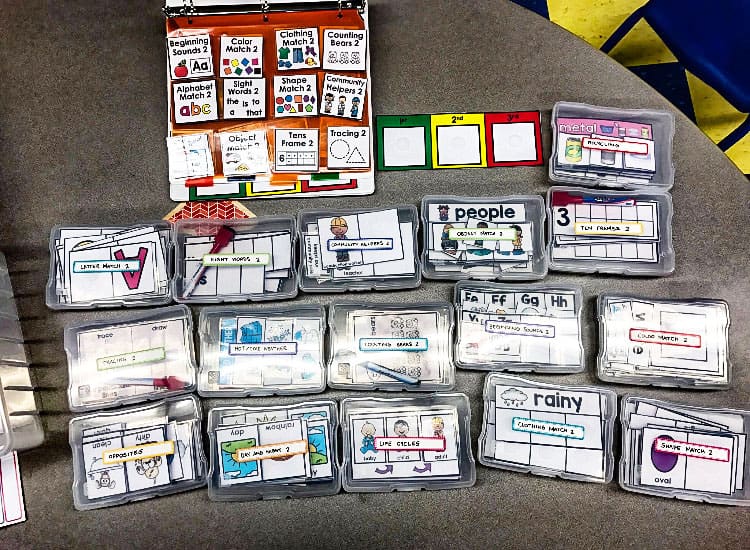
Task boxes are a fantastic resource for educators in a special education classroom. They consist of individual activities or tasks that offer structured learning opportunities for students to develop and practice specific skills. These boxes typically contain various materials like puzzles, flashcards, matching games, and manipulatives tailored to suit students’ individualized needs and abilities.
Types of Task Box
Task boxes are carefully curated to meet the individual needs and goals of students with diverse abilities. Depending on the resources and technology available, they can be physical, digital, or a combination of both.
Physical task boxes
Physical task boxes can be created using storage containers with clearly labeled compartments. Materials can range from manipulatives, flashcards, puzzles, or any other sensory or tactile resources appropriate for the targeted skill areas.
Digital task box apps and websites
Technology can greatly enhance task box activities in special education classrooms. There are numerous digital apps and websites that offer customizable and interactive task box options. These include platforms like Boom Learning, Task Box Fill, or Seesaw, which allow for engaging virtual activities and progress tracking.
Picture-based schedules and visual supports
Visual schedules are an essential part of special education classrooms. Using visual supports like picture schedules or visual task cards within the task boxes can provide clear step-by-step instructions for students to follow independently.
Why are Task Boxes Important in a Special Education Classroom?

Promoting Independence and Autonomy
One of the primary goals of special education is to foster independence and self-reliance.
Task boxes promote independence and autonomy among students with special needs. By engaging in these self-directed activities, students can independently work through tasks at their own pace and with minimal guidance from teachers, support staff, or parents.
This promotes confidence, decision-making skills, and a sense of accomplishment as students complete tasks successfully. In addition, this autonomy boosts confidence and empowers students to take ownership of their learning journey.
Visual supports
Visual supports are essential for many students with special needs, as they enhance comprehension and facilitate communication. Task boxes can be designed with visual aids, such as picture schedules, visual step-by-step instructions, or symbol-supported activities. These visual prompts help students understand tasks, follow directions, and complete activities effectively.
Targeted Skill Development

Task boxes are designed to target specific skills that students need to develop. These can range from fine motor and gross motor skills to cognitive, communication, and social skills. By practicing these skills repeatedly in a structured and engaging manner, students can strengthen their abilities and work towards achieving their individual goals.
Differentiated Instruction

In our special education classrooms, students have diverse abilities and learning styles. Task boxes offer a way to deliver instruction in a differentiated manner, catering to the unique needs of each student. We can create task boxes that are tailored to meet the individualized goals and objectives of our students, and this ensures meaningful and relevant learning opportunities.
Engagement and Motivation
Task boxes are designed to be visually appealing and engaging for students. With colorful materials, interactive elements, and hands-on activities, these boxes capture students’ attention and maintain their interest throughout the learning process. This enhanced engagement leads to increased motivation, active participation, and a positive attitude towards learning.
Progress Monitoring and Data Collection
Task boxes serve as valuable tools for progress monitoring and data collection in a special education classroom. Teachers can observe and document students’ performance, noting areas of strength and areas that require additional support. This data helps in making informed instructional decisions, modifying or adapting tasks to better meet students’ needs, and tracking progress over time.
Generalization of Skills
Task boxes provide opportunities for students to generalize skills learned in the classroom to real-life situations. For example, a task box activity that involves sorting objects by color can be extended to sorting items in a grocery store or organizing items at home. This promotes the transfer of skills and helps students apply what they have learned in meaningful contexts.
How to Successfully Implement Task Boxes

Identify Individual Goals and Objectives
Before implementing task boxes, it is crucial to identify each student’s goals and objectives. By aligning task box activities with specific learning targets, teachers can ensure that students are engaging in meaningful and purposeful practice.
Create an Organized System
Establish a well-organized system for storing and accessing task boxes. Label each box with clear instructions and expectations, ensuring that students can easily understand and navigate through the activities independently.
Introduce and Model
Take the time to introduce each task box activity to students, providing clear instructions and modeling the expected behaviors. This initial guidance and support will help students understand the purpose of each task and how to engage with the materials effectively.
Implement a Rotation System
Implement a rotation system where task boxes are regularly changed or updated. Such a system will help to avoid monotony and provide variety. This, in turn, keeps students engaged and interested, preventing boredom or disengagement.
Monitor and Provide Feedback
Regularly monitor students’ progress as they engage with task boxes. Provide feedback and positive reinforcement to acknowledge their efforts and achievements. This helps to build students’ self-confidence and motivation.
The Last Word
Task boxes play a vital role in our special education classrooms, offering a range of benefits for students with diverse needs. From promoting independence and autonomy to targeting specific skills, these structured learning opportunities enhance engagement, facilitate progress monitoring, and support differentiated instruction.
By effectively implementing task boxes, we can create an inclusive and empowering environment that fosters our students’ overall development and growth.
Anonymous says
December 10, 2023 at 6:15 pm
I love task boxes and use many of yours! Another great thing about them is when I have an adult up in your room & I am supposed to utilize them in some way, if they aren’t great with the students, I always have a pile of in progress task boxes for them to work on!
Leave a Reply
Your email address will not be published. Required fields are marked *
This site uses Akismet to reduce spam. Learn how your comment data is processed .
We have a wonderful and generous group of teachers in our MFML Facebook Group. Join us and discover everything you need to know about using MFML in your classroom.
Made for Me Literacy
Are you following Made For Me Literacy on Facebook and Instagram? We are always sharing news, updates, and tips on our socials. Don’t miss out – click below and follow MFML today!
Join the Especially Education social media communities for the latest updates, as well as tips and advice for special education educators like you.

Task Boxes for Special Education
To be successful in the classroom, students in special education may need additional support and accommodations. Utilizing task boxes for special education is an efficient method for providing this support. It can come in various forms, such as differentiated instruction or the use of assistive technology. Target boxes are a simple yet effective technique for helping kids in special education remain organized, focused, and on task. They are versatile resources that may be used to teach various academic and life skills, including personal cleanliness and time management.
This blog article will discuss the benefits of task boxes and how they may be utilized to serve students with special needs in the classroom. Read on if you are a teacher, parent, or caregiver seeking strategies to assist your special education student achieve success! It could include understanding how to implement curriculum modifications and exploring resources like the Council for Exceptional Children .
What Are Task Boxes for Special Education?
Special education students can benefit from using task boxes as a teaching tool because they assist students in maintaining a sense of structure and attention while completing assignments. They are pre-labeled collections of resources and activities meant to teach a specific skill or topic. These items are stored in a box or similar container from which the student can quickly retrieve them. Task boxes can benefit math, reading, writing, and life skills.
Mathematical topics like counting, addition, subtraction, multiplication, and division may be practiced with the help of worksheets and manipulatives like counting bears or base ten blocks contained in a math task box. Reading task boxes can also include materials like flashcards and worksheets to assist kids in honing their reading abilities. Tasks for social skills, time management, and even personal hygiene can all be found in a life skills toolbox.
Students can work at their own pace and skill level with the help of task boxes for special education developed for this purpose. Since the task box activities can be completed independently, children who require special education services can complete their work in class. Students in special education can benefit from the one-on-one attention and supplementary materials provided by using task boxes in a small group environment. Teacher-led small group instruction on a topic or skill followed by individual student practice with the task box is only one possible application.
In conclusion, task boxes are an excellent tool for assisting children with special needs to achieve academic success. Students can use them to hone their abilities in an organized and well-organized fashion.
Additionally, they allow children to work autonomously, which benefits the growth of self-control and confidence. Individualized instruction is possible with task boxes since they may be modified to meet the needs of each learner. It echoes the Universal Design for Learning principles, which advocate for flexible learning environments that accommodate individual learning differences.
What Are Task Boxes Used For?
In special education classrooms, task boxes can be utilized for various objectives. Common applications include:
- Teaching academic skills: Task boxes can be used to introduce a variety of intellectual abilities, including mathematics, reading, writing, and science. They may include worksheets, manipulatives, and other hands-on things required to complete the tasks associated with the given skill or subject.
- Practicing and reviewing skills: Task boxes can be used as a method for students to practice and review previously acquired abilities. They may comprise several exercises aimed at aiding students in retaining and applying their knowledge.
- Developing independence: Task boxes can assist pupils in becoming more autonomous learners. Children can independently build self-regulation and self-advocacy abilities by completing the task box exercises.
- Providing individualized instruction: Task boxes can be adapted to the exact needs of each student, making them a perfect tool for personalized training. Teachers can construct assignment boxes for each student tailored to their specific skills and shortcomings.
- Life skills: Materials for life skills such as personal hygiene, time management, and social skills can be included in task boxes. They can be used to educate and practice these critical skills for independent living and community success.
- Addressing specific challenges: Task boxes can be utilized to address unique issues, such as attention impairments, sensory processing abnormalities, and developmental delays, that kids in special education may face.
Free Task Boxes for Special Education Students
Task boxes are useful for children in special education, and several open-source tools are available to help teachers make them. Optional items include:
- Online resources: Numerous websites offer free printable workbox templates and other tools for pupils in special education. Worksheets, activity suggestions, and other downloadable items are examples. Pinterest and The Autism Helper are two other good examples.
- Open-source materials: There are a variety of open-source resources that may be used to make task boxes. Free printable worksheets, activities, and other resources can be utilized. The OpenSesame and the Open Education Database are two such instances.
- Libraries: Check with your local library to see if they have any resources relating to task boxes that you can borrow or use as a starting point for your projects. Some public libraries may find books containing exercises, games, and other content suitable for a task box.
- DIY: Do-it-yourselfers, rejoice! Task boxes may be fashioned from everyday household items. You can organize your tasks using plastic bins, cardboard boxes, and drawers. You can stock them with resources like worksheets and manipulatives tailored to the topic or skill.
It is encouraged to check with the particular education instructor before accessing any free resources, as they may not always be appropriate for your student’s individual IEP. Now you know task boxes for special education are free.
Where To Buy Task Boxes for Special Education?
Both online and in physical locations, a range of job boxes for special education are available for purchase. Some alternatives include:
- Online retailers: Numerous online shops sell task boxes for pupils in special education. These sites can include Amazon, TeachersPayTeachers, and Target. These vendors provide a vast selection of workboxes covering a variety of disciplines and skills, including arithmetic, reading, and life skills.
- Special education supply companies: Other businesses sell task boxes and special education items. These businesses may provide broader options and specialized task boxes for particular courses or abilities. Good Stuff, Learning Resources, and Hand2Mind are a few examples.
- Local stores: Some local retailers may also carry task boxes for pupils in special education. These can range from educational supply stores like Michaels to major stores like Walmart.
- Custom-made task boxes: Some companies also offer bespoke task boxes suited to students’ needs. It can contain task boxes for students with particular learning difficulties or disabilities.
Notably, acquiring task boxes can be pricey, and checking the materials and quality is always advisable before purchasing. Additionally, it is essential to ensure that the workboxes correspond with the student’s IEP before making a purchase. These are the task boxes for special education for sale.
How To Make DIY Task Boxes for Special Education
Students in special education can benefit from DIY task boxes since they can be made to meet the student’s unique needs and be made on a budget. To help you make your task boxes, here are some guidelines:
- Gather materials: A plastic bin, cardboard box, or drawer are good options for housing the task box’s contents. You’ll also need worksheets, manipulatives, and other hands-on objects relating to the skill or topic you’re trying to impart.
- Plan the tasks: The first step in creating a successful task box is carefully planning activities. Create a to-do list that corresponds with those competencies or areas of study, tailoring it to the learner’s age and skill level.
- Organize the materials: After gathering your chores and supplies, it’s time to start putting everything in order in the box. To keep the various components of a project distinct from one another, you can use separators or little plastic bags. Identify the purpose of each activity and the supplies needed by the student.
- Add visuals: Consider including photos, symbols, or written instructions to help pupils who learn best by seeing how something is done.
- Test and adjust: Once the task box is finished, please test it with the student and make any necessary revisions. For instance, if a student struggles with a particular assignment, you may need to modify the position or offer more help.
- Use them: You can use the task boxes on their own or as a part of a broader lesson plan for individual or small group work.
If a student has an Individualized Education Program (IEP), the special education teacher should be consulted before creating task boxes. Remember that task boxes are meant to supplement the student’s learning, not to replace the teacher’s role in the process. Learn the task boxes for life skills and task boxes for autism.
Jennifer Hanson is a dedicated and seasoned writer specializing in the field of special education. With a passion for advocating for the rights and needs of children with diverse learning abilities, Jennifer uses her pen to educate, inspire, and empower both educators and parents alike.
Related Posts

Peer Mediated Instruction

Academic Enrichment

7 Special Education Task Box Ideas
- Task Boxes , Independent Work Systems , Academics

Special Education Task Box Ideas
Are you using task boxes in your special education classroom yet? If not, what are you waiting for?! There are a ton of reasons why you should use task boxes in your classroom. Students gain proprioceptive feedback while learning new skills. Plus, task boxes are fun and engaging and keep kids wanting to learn and practice skills over and over again.
My favorite way to use task boxes is during independent work stations . Does it seem overwhelming to come up with ideas to create enough tasks to rotate through? That's where I have you covered! Below, I've listed 7 special education task box ideas with links to each to print and make your own!
You can even grab 4 FREE TASK BOXES RIGHT HERE TO TRY FIRST!

1. Life Skills Task Boxes
If you've been around for long, you know how much I believe in teaching my students true life skills . I believe this whether they are in elementary or high school . Creating task boxes based around life skills is totally a win-win. Students get set practice time to practice the life skills that they need, plus you can incorporate life skills into independent work systems this way. Some examples of life skills task boxes might be: reading environmental print, safety community signs, household vocabulary, practice with money, and choosing what to wear for the appropriate weather.
GRAB THE LIFE SKILLS TASK BOXES HERE!

2. ELA Task Boxes
I love incorporating ELA task boxes into small groups or our independent work stations during the day. This way, students can get extra practice on the new reading skills that we are learning. Independent centers promote stamina, decrease prompt dependence, and increase problem-solving. ELA task boxes help students work on skills such as main idea, comprehension, sequencing, vocabulary, CVC words, rhyming character traits and SO MUCH MORE!
GRAB THE ELA TASK BOXES HERE!

3. Math Task Boxes
These math task boxes can be used all year and have a variety of skills (32 skills to be exact) , depending on your students' IEP goals . Some skills that these contain are counting to 20, more or less, addition, subtraction, tracing numbers, telling time, counting coins and patterns, just to name a FEW! Try a FREE sample math task box here!
GRAB THE MATH TASK BOXES HERE!

4. Science Task Boxes
Continue the academic feel with your task boxes and get creative with some science-themed tasks ! Your students can have fun with magnets, recycling, the five senses, plants, animals, and weather just to name a few topics.
GRAB THE SCIENCE TASK BOXES HERE!

5. Social Studies Task Boxes
Incorporating social studies topics is another great idea for task boxes. This can include topics such as community helpers, government, using a map, and directions. I love using these during small group time to make sure that we are discussing social studies in my classroom but in a fun and engaging way.
GRAB THE SOCIAL STUDIES TASK BOXES HERE!

6. Errorless Task Boxes
Errorless tasks are a big hit in my room. They help to build student confidence, while still working on independent skills during independent work stations . Not sure what errorless learning is or why it's beneficial? Check out this post all about errorless learning. There are 5 different ways that I use errorless learning in my classroom. Task boxes are one of the ways! Here's a FREE sample!
GRAB THE ERRORLESS TASK BOXES HERE!

7. Matching Task Boxes
The final type of task box I want to chat about is just simple matching task boxes. This is such a great skill for our students to know. It's one of the best ways to use a task box in an independent work center because students can be pretty self-sufficient with knowing what to do. Have students match different vocabulary items that you are focusing on or have it be a holiday theme. The ones that I use focus on matching items such as fruit, vegetables, animals, clothing, and body parts.
GRAB THE MATCHING TASK BOXES HERE!

WANT ALL THE ACADEMIC TASK BOXES ABOVE?
Grab the bundle here.

I am a High School, self-contained Autism teacher from Central New York, who is passionate about individualizing student learning. I am a mommy of three, lover of all things Disney, married to my best friend and addicted to chocolate!! I hope that you find great ideas and inspiration here, so welcome!!
REcent Posts

Part 6- Communication [Episode 35]

Part 5- All the Materials [Episode 34]
Featured resources.

You Might Also Like...

Leave a Reply Cancel reply

Shipping Note:
Physical boxes will be shipped out on the first week of each month. If you purchase on the 2nd, your first box will not arrive until the next month. I.e. If you start your subscription January 15, your first box will arrive in February. All subscriptions will receive immediate access to digital files.
Subscriptions are set to renew on the 1st of each month unless you opt for the annual plan.

Adapted Resources
Seasonal & holiday, life skills.
Special Educator Academy
Free resources, how can i make good task boxes for special education students.
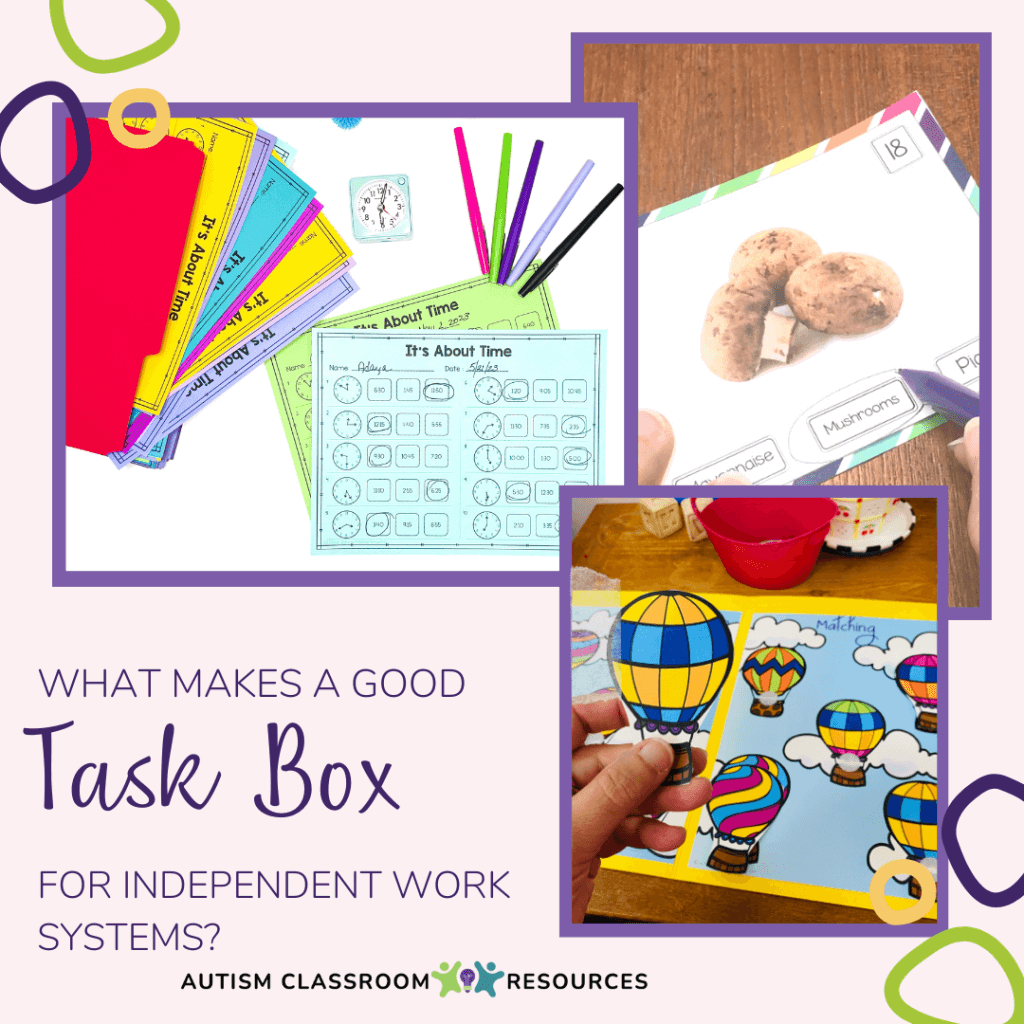
Sharing is caring!
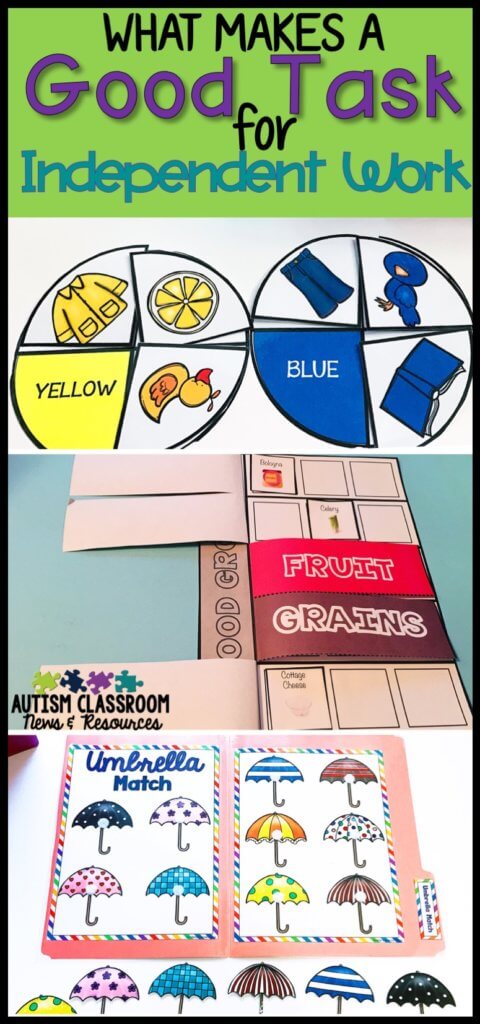
So many times I walk into a special education classroom and see that a special education teacher has independent work systems set up. But when I look at the system, I see a number of elements that don’t fit the philosophy behind them.
Sometimes they are missing elements like finished baskets. Occasionally the task is set up right to left instead of left to right. And sometimes they have tasks are not a good fit. This blog post will give you different ways to set up task boxes for special education students.
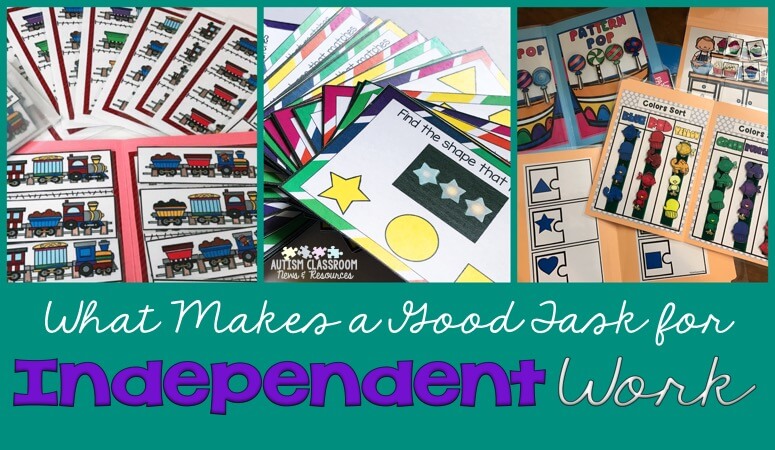
This post includes affiliate links. If you purchase an item through the link, I get a small commission. You get the item at the same price. I would never recommend something I didn’t use and find helpful in classrooms.
Let me stop and say that I love independent work and independent work tasks! If you have been reading this blog for a while, I’m sure that’s not news. I like them so much, I wrote a book about them . Our students spend so much time with people giving them direct instruction and supervision that learning to work on their own is such a critical skill. So when I see a work task system that is not set up to focus on the teaching of independence, I worry. You can read more about setting up systems here and more things you need to know in this post.
Not sure what independent work systems are? Read this post.
5 Elements You Must Have for Independent Task Boxes for Special Education Students

So what makes a good independent task boxes for special education students? Some of these elements (the first 3) are based on the original conception of structured work systems from TEACCH . Some are elements that I look for in creating the tasks to make them most useful.
1. Mastered Tasks
To some this seems evident, but it is the most common problem I see. There are several reason why tasks have to be independent skills that the student has mastered.
First, we are not teaching the student to do the tasks in the system. We are teaching the students to work on their own. Let’s say the student can’t count with 1-1 correspondence and we give him a task that requires it. Does he not finish the work system because he got stuck with 1-1 correspondence or because he was waiting for a prompt?
In short, if you want someone to do something independently, the independent tasks have to be something they have shown they are able to do. Otherwise you can’t tell whether the task is the problem or being dependent on prompts is.
2. Clear Beginning and End
Students need to clearly understand what work is expected to be completed. If you can’t tell when a task is finished, how do you know when to put it away? Similarly, many of our students get overwhelmed when they are presented with tasks. Having a clear beginning and end helps them see what work is expected and makes it easier to start the work task boxes.
To make the expectations clear, there are a few things you can do and a few things tasks need to be built with.
- Only include pieces of the task you expect the student to finish. If you want them to sort 10 items, don’t put 20 in the box and expect them to know it.
- Make sure that the number of pieces of tasks (like a matching task) are the number needed to complete the tasks. Too few pieces and the student gets frustrated. Too many pieces and he isn’t sure what to do with the extra pieces.
File folders, puzzles, and worksheets (along with other visual motor tasks) are good fits for the systems. Writing essays (without clear guidelines of length), verbal tasks, and computer-based tasks that have no specific ending are not good options.
3. Designed to Stay Together
This is important for two reasons. First, if tasks fall apart, students will want to put it back together. Remember that we don’t want the students to take their work apart. It’s demoralizing to have to undo work you worked hard to do. It’s also the opposite of what we are trying to teach. If a worker filled up the salt shakers in a restaurant, we wouldn’t ask him to empty them all right afterwards. Similarly, if he did a math worksheet in a general ed. class, we wouldn’t want him to erase his answers.
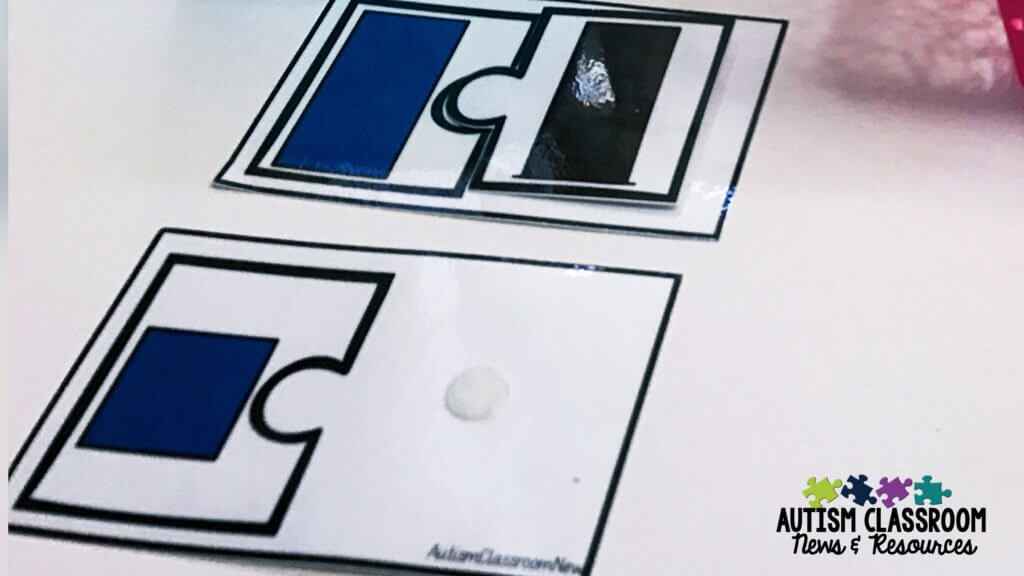
Second, we want to be able to check their work. Ever have that student who just puts pieces on a file folder, folds it up and says it’s done? Yea, me too. Being able to check their work is a great way to avoid this. As students get more proficient at using the system, a perfect way to expand their skills is to require them to raise their hand and have their work checked before getting the reinforcer. The good news is, this allows you to catch those slick kiddos who just looked like their work is complete.
4. Easily Differentiated
This one isn’t necessarily a TEACCH issue, but when looking for tasks that will last and meet the most needs, I like to find one that are easy to adjust for use with different students. Task cards are a great example. I can give the student as many (or particular ones) as they can do, but not more. So one student gets 20 cards and one gets 5. Similarly, maybe one gets the task cards for squares only (since that’s as far as you have gotten) and other students get squares, triangles and rectangles.
File folders can be made in pieces. If you have a student who can’t sort all the shapes, make a folder with just one side of the shapes, so it only has square, triangle and circle.
Use mats instead of file folders. Instead of making all the pages into file folders, make some as mats. Then you can switch them up and give more items to match or less. The trains in my Detail Discrimination tasks are a good example for a task box system.

5. Visual and Engaging
Finally, it helps to have task boxes for special education students that are visual and interesting. Students are more likely to engage with task box activities that they find interesting, so incorporate special interests. You can see some examples in this post. It’s also helpful to capitalize on the fact that many of our students have strengths in visual discrimination. Use that strength to have them practice a variety of other skills.
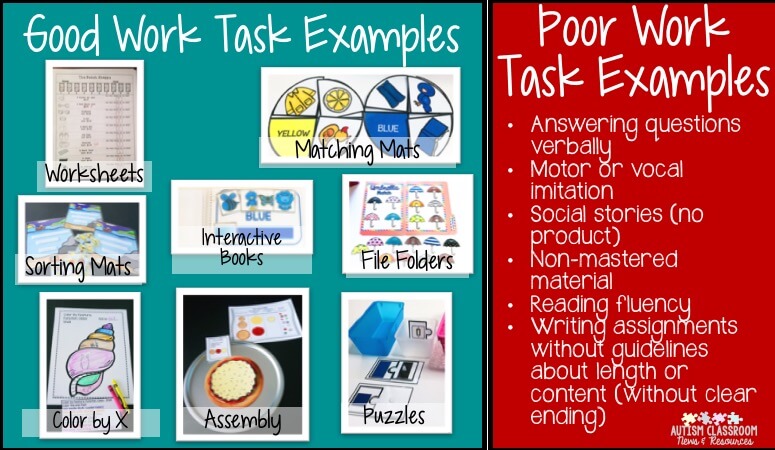
Obviously having tasks that are age-appropriate is important as well and I’ll tackle that in a future post. In the meantime, if you are looking for work boxes designed specifically for independent work systems, check out the ones below in my Teachers Pay Teachers store.
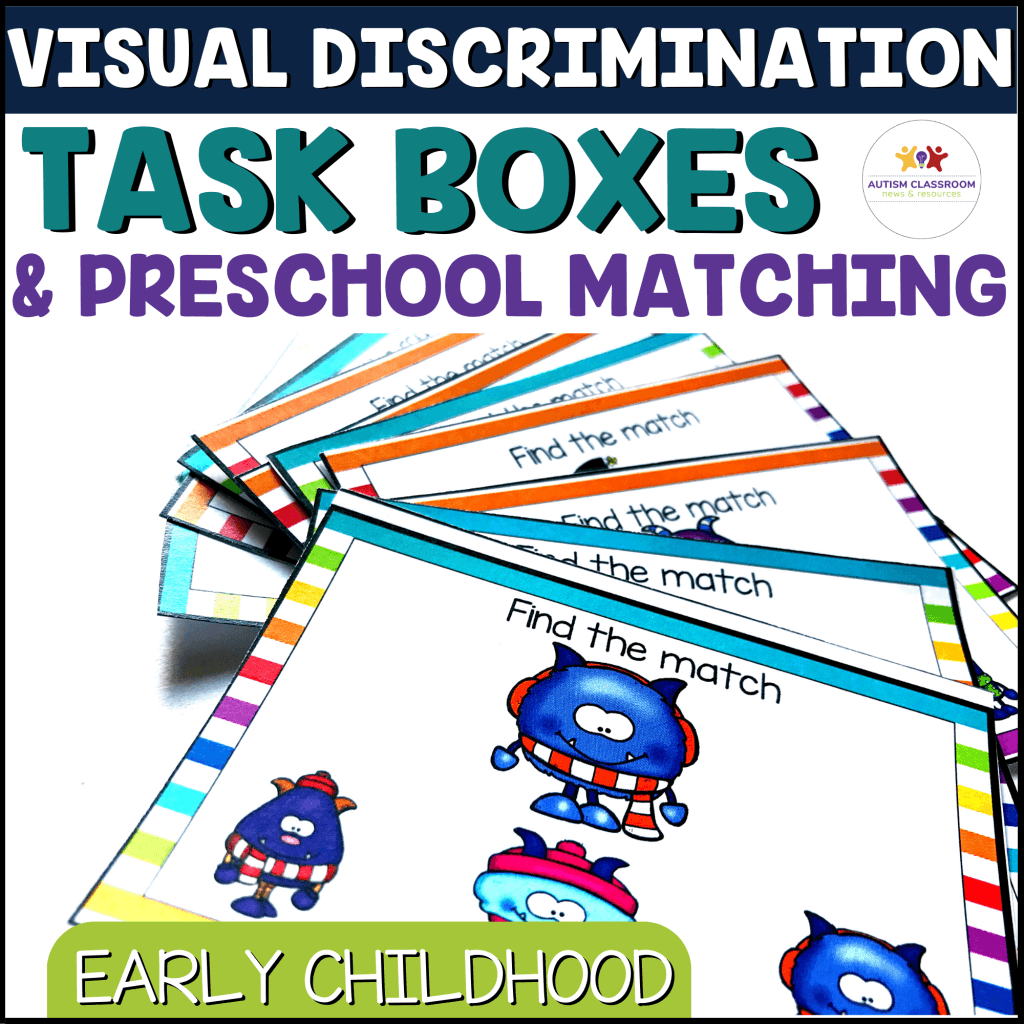
Check out these bundles for individual products for different ages.
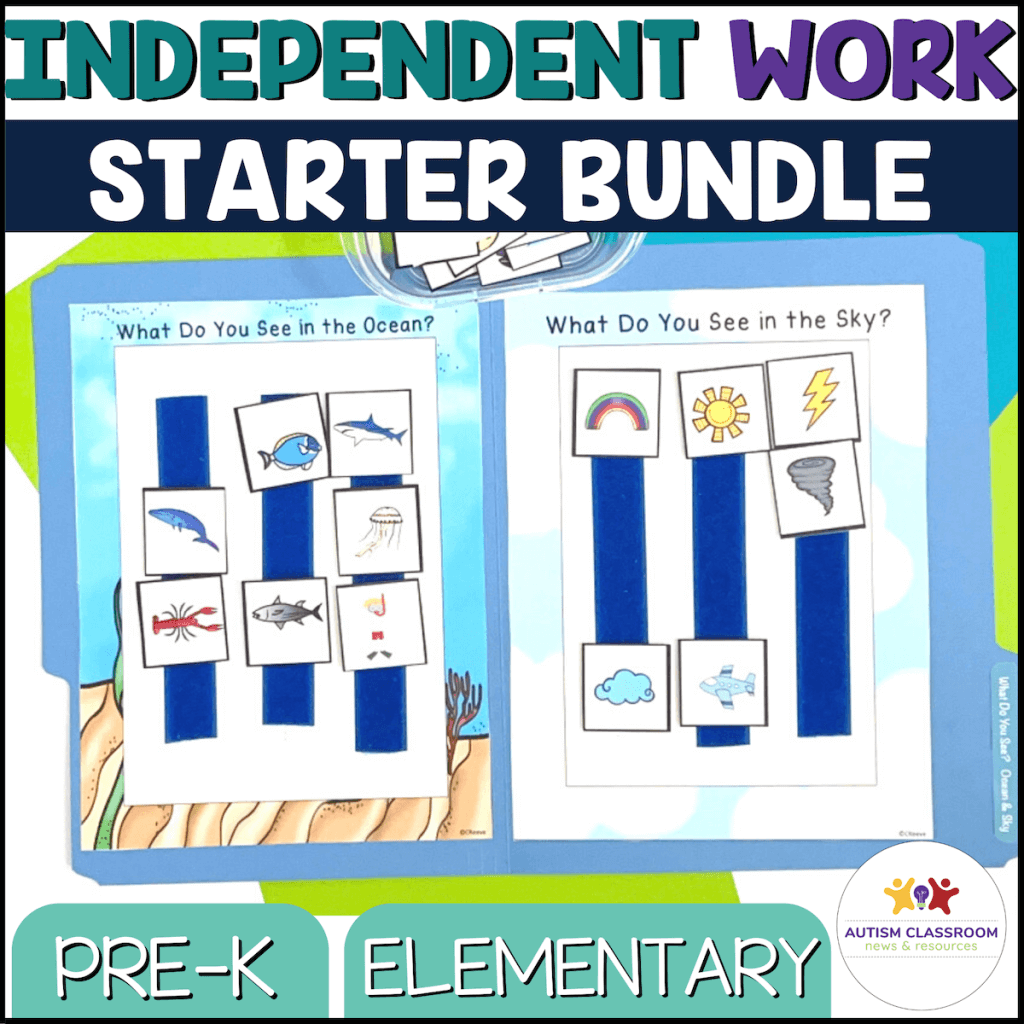
- Read more about: Task Boxes Independent Work Systems
You might also like...


3 Task Box Activities Perfect for Telling Time Practice
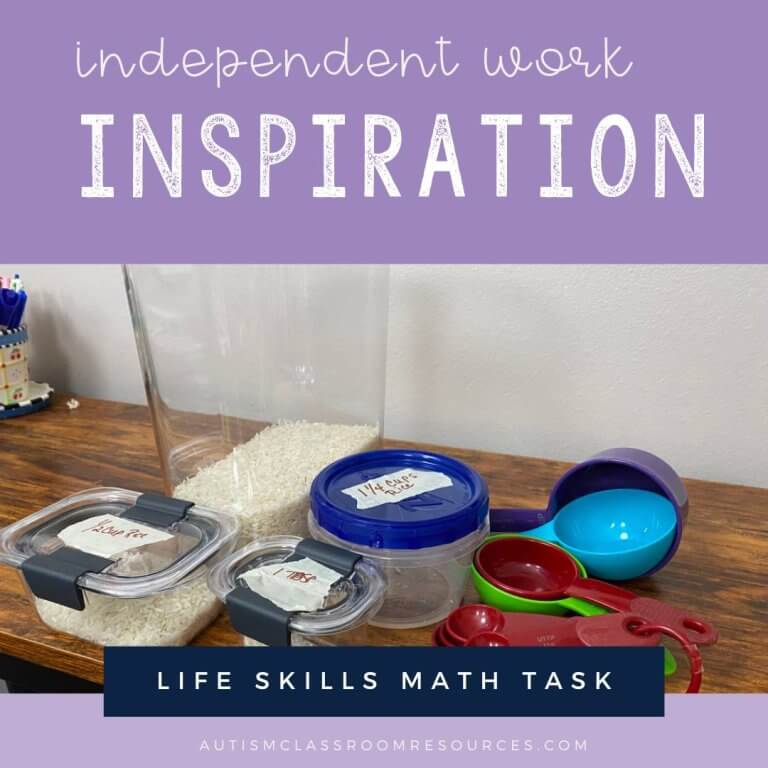
Life Skills Math Task Box Idea: IWInspiration for Practicing Measurement

Free Holiday Resources for Winter to Keep Students Engaged
![special education tasks Independent Work-3 Ways It can Become Your Best Classroom Management Tool [A sorting task in a shoebox to sort nouns from verbs on popsicle sticks into plastic cups]](https://autismclassroomresources.com/wp-content/uploads/2023/06/BLOG-22208-3-Ways-Task-Boxes-and-IW-Help-Classroom-Management-2-768x644.jpg)
3 Ways Independent Work Task Boxes Help Conquer Classroom Management
Grab a free resource.
(and get free tips by email)

Training & Professional Development
- On-Site Training
- Virtual Training
Privacy Policy
Disclosures and copyright.
- Core Beliefs
Unlock Unlimited Access to Our FREE Resource Library!
Welcome to an exclusive collection designed just for you!
Our library is packed with carefully curated printable resources and videos tailored to make your journey as a special educator or homeschooling family smoother and more productive.


Task Boxes for Special Education: Download a Set of Fun and Free Fall Task Boxes
Today, I want to talk to you about a powerful and engaging tool that has proven to be incredibly effective in teaching and inspiring young children with special needs: task boxes. Task boxes for special education are a fascinating way to deliver essential skills.
As an expert in elementary special education with 15 years of experience, I have seen first hand how task boxes can make a remarkable difference in the learning journey of our students.

So, let’s dive into the world of task boxes and discover how they can create a fun and exciting learning experience for our children with special needs.
Target a wide variety of skills with these work task boxes. Read all about some fun and free task box ideas, if you’re looking for social emotional learning activities to add to your curriculum, I’ve also got you covered!
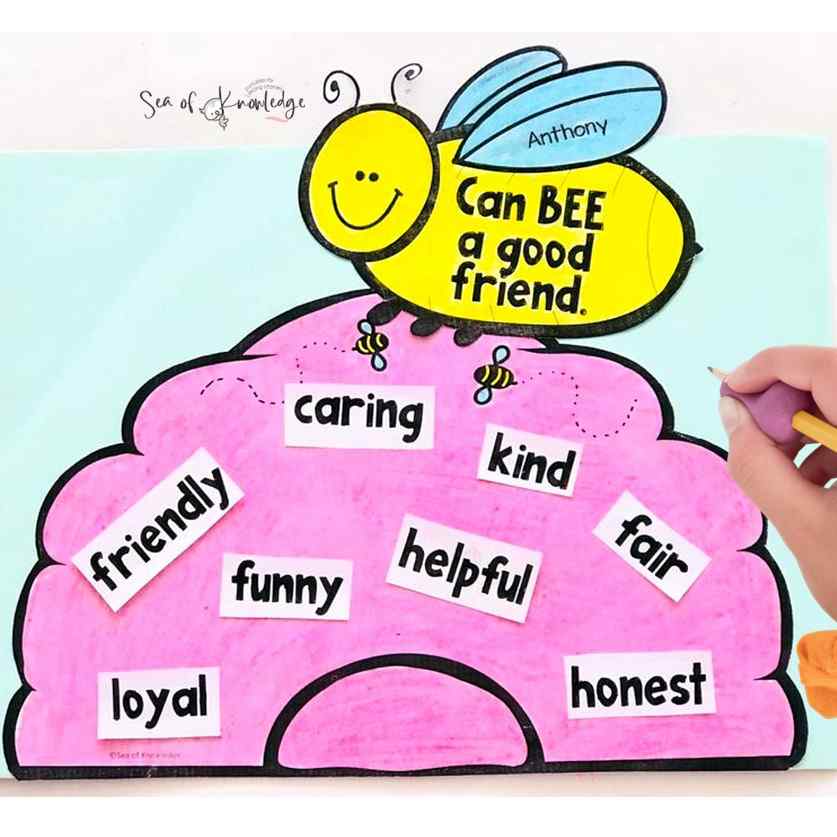
What are Task Boxes?
If you’re not familiar with task boxes, don’t worry—I’m here to help. Task boxes are sets of activities, puzzles, or learning tasks that are carefully designed to target specific skills and concepts.
They are typically presented in small, portable containers or bins, which makes them ideal for independent work or as part of a structured work system.

Each task box focuses on a particular learning objective, allowing students to practice and reinforce their skills in a controlled and repetitive manner.
These activities can cover a wide range of subjects, from basic math and language arts to fine motor skills and sensory exploration.
The versatility of task boxes makes them a perfect fit for students with diverse learning needs and preferences.
As special education teachers, we are always on the lookout for innovative and effective ways to engage our students and help them develop essential skills.
Get these 9 SETS at the end of this post.

Task boxes, also known as task cards or work boxes, have proven to be a great addition to any special education classroom.
These carefully crafted activities target basic skills and align with IEP goals, making them an excellent tool for promoting independent skills and errorless learning.
Task boxes, often stored in plastic boxes or bins, consist of a wide variety of activities that cover different subjects and skill levels.
These boxes are designed to provide students with opportunities for extra practice, allowing them to learn and reinforce new skills at their own pace.
Task boxes can be used individually, in small groups, or as independent work tasks, making them suitable for both self-contained classrooms and inclusive settings.
Introducing The Task Box Library
Are you looking for a comprehensive and cost-effective solution to enhance your special education classroom or home learning environment?
Look no further! The Task Box Library Monthly Membership by Nikki over at Teaching Autism, offers an incredible opportunity to unlock a whole library of task boxes and enrich your teaching repertoire throughout the entire year.

I would highly recommend this offer if you are in special education. It will literally save you TONS of time and money throughout the year.
What are the features?
Early Bird Annual Fee of $85: We understand the importance of budget-friendly resources for educators and parents alike. That’s why we’re excited to offer an exclusive early bird annual fee of just $85 for our membership.
This incredible value grants you access to an extensive collection of over 200 task box cards at your fingertips!

Unlock a Whole Library of Task Boxes: Imagine having access to an ever-expanding library of engaging and skill-focused task boxes, all designed to cater to the unique needs of your special education students.
Nikki’s Task Box Library covers a wide range of subjects, including fine motor skills, basic concepts, language arts, math, sensory exploration, and much more.
Say goodbye to searching for individual resources; our membership gives you all the task boxes you need in one convenient place.

Use Throughout the Entire Year: With our Task Box Library Monthly Membership, your access to the vast array of task boxes is not limited to a specific timeframe.
You’ll have the freedom to use these resources throughout the entire year, allowing you to plan your lessons, rotations, and activities with ease and flexibility.
Whether it’s for in-classroom instruction, independent work stations, or home learning, our task boxes are the perfect companion for year-round engagement and skill development.
Why Choose The Task Box Library Monthly Membership:
- Save Time and Money: As a special education teacher or parent, time is precious. Our membership simplifies your teaching planning and preparation, enabling you to focus more on your students’ individual needs.
- Access to Over 200 Task Box Cards: Our extensive collection of task box cards covers a broad spectrum of skills and subjects, ensuring that you have resources for all learning levels.
- Diverse Learning Opportunities: The variety of task boxes allows you to tailor your instruction to each student’s unique strengths and challenges, providing a personalized learning experience.
- Support for the Entire Year: No more worries about finding new resources every month. With our membership, you have access to task boxes that can be used seamlessly throughout the entire academic year.
- Ideal for Teachers and Parents: Whether you’re a special education teacher looking to enhance your classroom or a parent eager to support your child’s learning at home, our Task Box Library Monthly Membership is the perfect fit.
Join The Task Box Library Monthly Membership Offer today and discover a wealth of engaging and effective resources that will elevate your teaching and inspire your students’ learning journey.
Unlock the potential of over 200 task box cards and watch as your special education students thrive!
Visit The Ultimate Task Box Library by Teaching Autism here to sign up now and take advantage of our limited-time early bird annual fee of $85.
Don’t miss out on this incredible opportunity to revolutionize your teaching with The Task Box Library!
Why are task boxes beneficial?
Task boxes have such a great place in special education and any classroom, I even use these with my ESL kids.
Promoting Independent Skills
One of the main goals in special education is to foster independence in our students.
Task boxes play a crucial role in achieving this objective by providing opportunities for independent work.

As students progress through each task, they gain confidence and a sense of accomplishment, leading to a higher level of self-reliance.
Implementing the Task Box System
To effectively integrate task boxes into our special education classrooms, we can establish a well-organized task box system.

If you’re looking for some FREE task boxes that you can get your hands on before you dip your feet into the fun world of task boxes. Check out these FREE task boxes from Nikki @ Teaching Autsim.
Math task boxes for special education
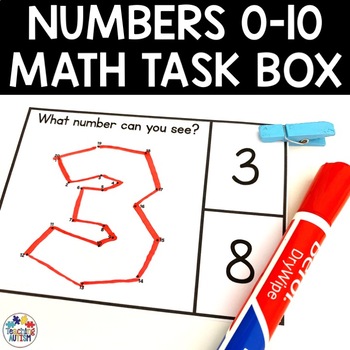
Here are some great ideas to get started:
- IEP Work Bins: Customize task boxes to align with individual IEP goals. This approach ensures that each student’s unique learning needs are met while promoting skill development.
- Visual Supports: Use visual supports like picture schedules or step-by-step guides to help students navigate through task boxes independently. Visual aids provide clear instructions and help minimize frustration.
- Task Box Bundle: Create task box bundles that target different areas of learning and offer a wide range of skills. A diverse selection caters to the varying abilities and interests of our students.
Fall-Themed Task Box
As a special education teacher and blogger, I recently curated a fall-themed task box bundle that I am excited to share with you.
Introducing the “Fall Task Box,” a collection of engaging and age-appropriate activities designed to improve fine motor skills and are a great way to explore the beauty of autumn.
The Fall Task Box includes activities such as using pipe cleaners to create leaf patterns, matching fall-themed popsicle stick puzzles, and sorting acorns by color.
These hands-on tasks provide sensory input and promote fine motor development in a fun and interactive way.
Download your free set below:
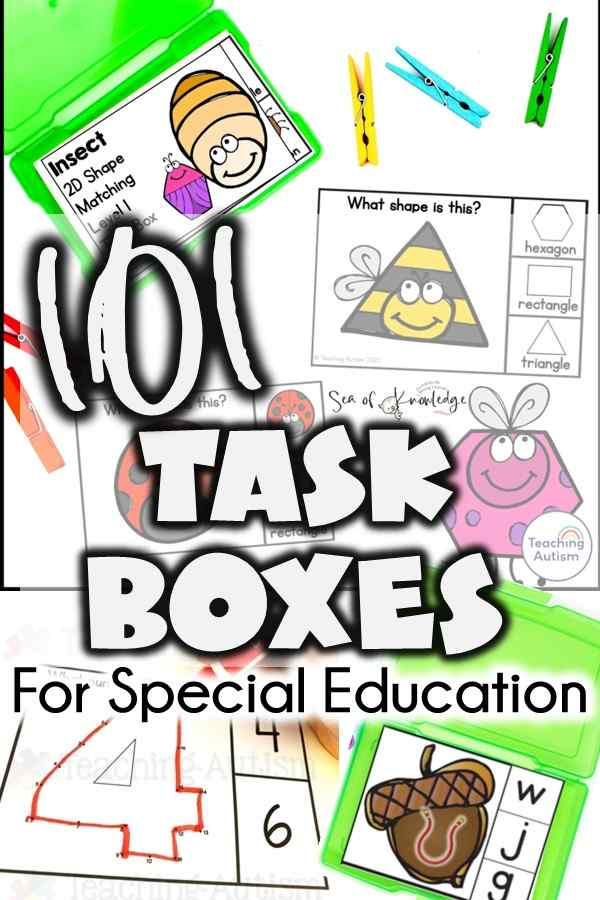
To make your journey into the world of task boxes even more exciting, I have prepared a set of fun and free fall-themed task boxes for you to download.

Fall Themed Task Boxes for Special Education
Signup to get this printable pack sent right to your inbox!
These task boxes are designed to align with common special education learning objectives, and they feature captivating autumn-themed images and activities that will surely delight your young learners.

Just visit to access this fantastic resource. Remember to print and prepare the task boxes with care, and get ready to witness the joy on your students’ faces as they embark on these engaging learning adventures.
In conclusion, task boxes are an invaluable tool for teaching and inspiring young children with special needs.
Their ability to engage, motivate, and accommodate various learning styles makes them an essential addition to any special education setting.
By using task boxes in independent work stations and following successful system ideas, we can create a meaningful and enjoyable learning experience for our students.
Thank you for joining me today as we explored the world of task boxes in special education.
Let’s continue to embrace creativity, fun, and individualized learning to empower our students to reach their full potential.
Implementing Task Boxes in Independent Work Stations
Task boxes are a great fit for independent work stations, which are essential components of any special education classroom. When setting up independent work stations, consider the following:
- Specific Times: Allocate dedicated periods throughout the day for independent work. This routine fosters a sense of predictability and allows students to focus on the task at hand.
- Task Box Rotations: Regularly rotate the activities in independent work stations, introducing new skills and challenges while ensuring variety.
- Higher-Level Tasks: For students who have mastered basic skills, introduce more complex tasks within the task boxes. This keeps them engaged and promotes continuous growth.
- Small Groups: Occasionally, have students work collaboratively on task boxes. This encourages peer interaction and cooperation, creating a positive social learning environment.
Task boxes are a powerful tool for promoting independent learning and enhancing fine motor skills in special education students.
By integrating these fun and engaging activities into our classrooms, we provide students with opportunities to learn and grow while fostering independence and confidence.
As special education teachers, let’s continue to explore different ways to use task boxes effectively and tailor them to meet the unique needs of our students.
Whether in self-contained classrooms, inclusive settings, or independent centers, task boxes have proven to be a valuable resource for helping our young learners succeed.
Remember, the journey of skill development is a marathon, not a sprint. Through task boxes and other innovative approaches, we can create a supportive and enriching environment that empowers our students to thrive.
So, let’s embrace the power of task boxes and watch our students flourish!
Similar Posts

Social Skills Activities for Special Needs Students Plus Freebie

Text Message Classroom Activity: Printable Writing Tasks

55+ FREE Summer Learning Activities for Kindergarten – (printables they actually want to do)

10+ Easter Fine Motor Activities for Preschoolers Pantry Items Crafts and Ideas
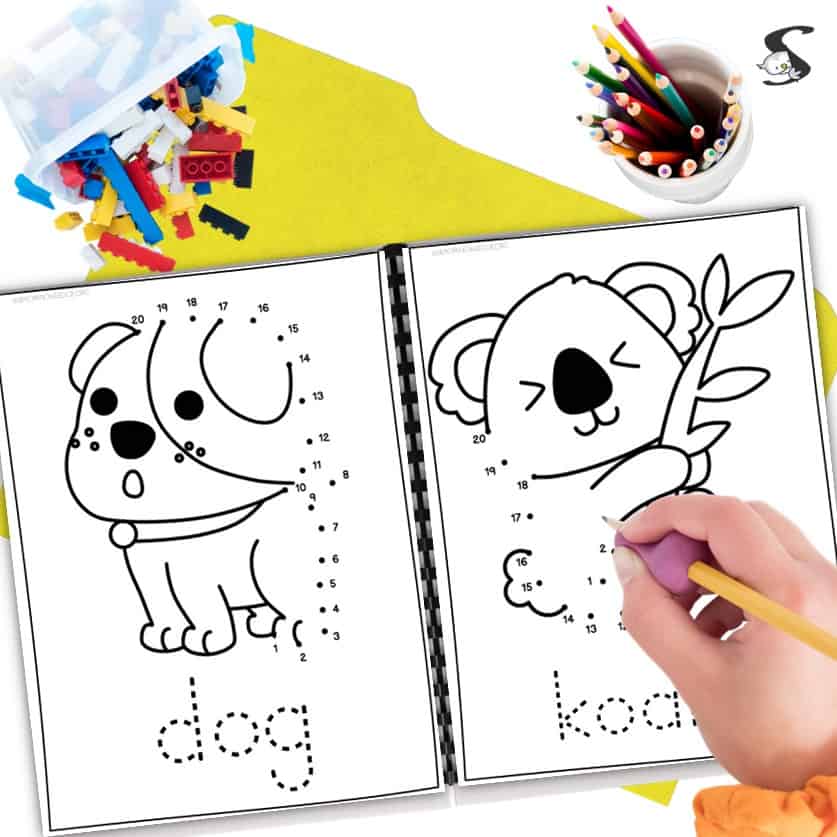
10 Dot to Dot to 20 Printable Activities for Kids
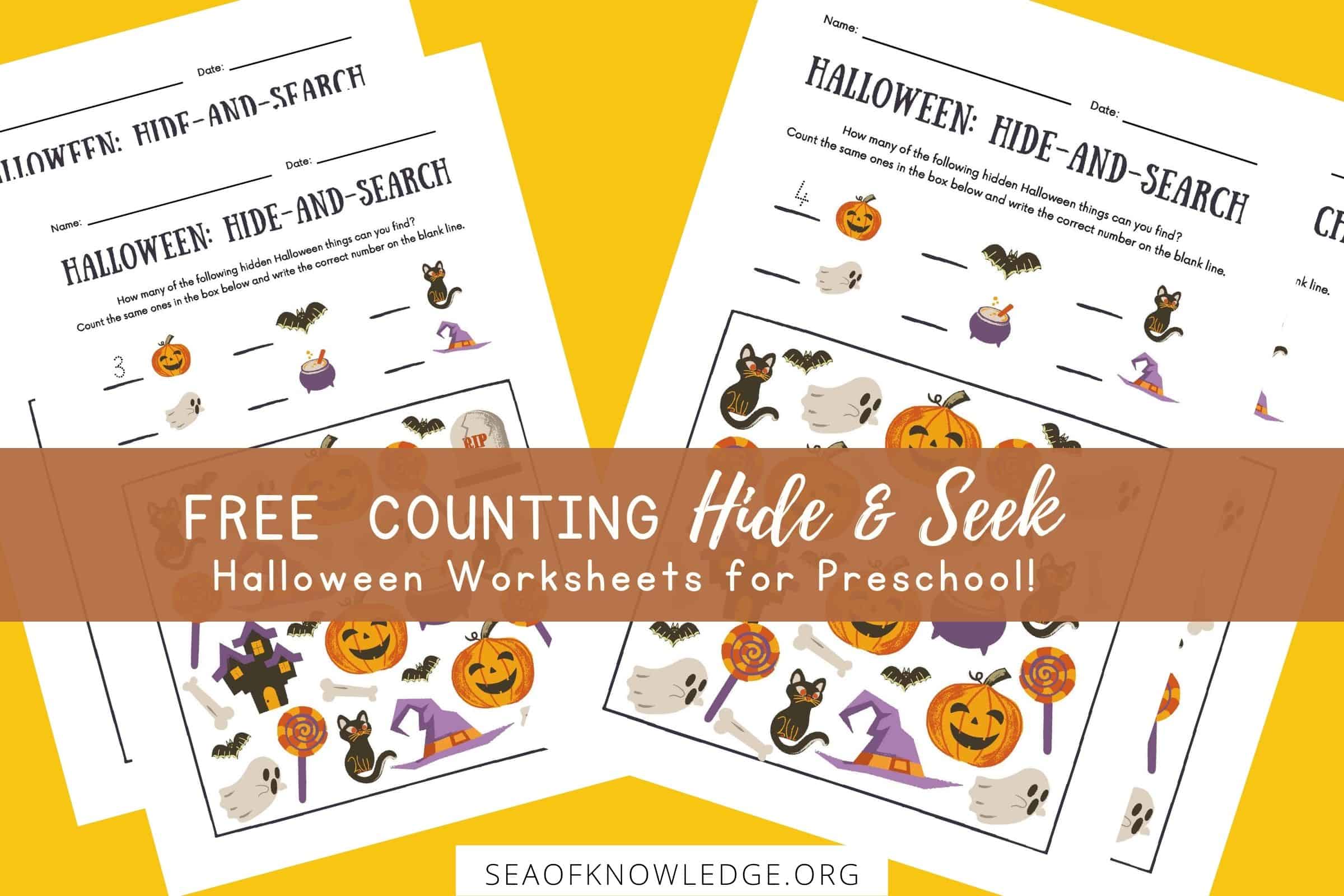
Preschool Counting Worksheets Halloween
Leave a reply cancel reply.
Your email address will not be published. Required fields are marked *
This site uses Akismet to reduce spam. Learn how your comment data is processed .

Vocational Work Task Mega Pack

Supporting Will’s Place: A Non-Profit Sandwich Shop

Engaging and Versatile Work Tasks

Realistic Photos and Everyday Examples

Comprehensive Instructions and Visuals

Wide Spectrum of Skill Levels and Vocational Skills

Easy Preparation with Inclusive Supply List

- Recent Posts
- Field Trip Success - May 20, 2024
- Summer is Here! - May 6, 2024
- Vocational Work Task Mega Pack - April 15, 2024
Submit a Comment Cancel reply
Your email address will not be published. Required fields are marked *
Submit Comment
The Radiant Spectrum

Task Analysis in Special Education: How to Deconstruct a Task
- September 15, 2022 April 11, 2024

As educators, we often go through the process of deconstructing a task by breaking down a complex skill into smaller steps so that students are able to learn the skill gradually, and easily. This process is known as Task Analysis and is especially crucial when teaching students with special needs.
We typically learn in two ways, explicitly and implicitly. Explicit learning is the intentional experience of acquiring a skill or knowledge, while implicit learning is the process of learning without conscious and deliberate awareness, such as learning how to talk and eat. Our students with special needs benefit more from explicit teaching and learning because they often face challenges acquiring skills implicitly due to the need for contextual understanding, communication skills, and so on.
For explicit teaching and learning to be effective, it is important to have a thorough understanding of the skill through task analysis.
Task Analysis involves a series of thought processes:
1. Goal Selection: Know exactly what it is that you want to teach
Be clear and specific about the goal or the skill that you want to teach. Avoid having too many sub-goals.
- Negative example: Play a complete song.
- Positive example: Press keys on the piano by following the alphabets shown on a flashcard or music score.
2. Identify any prerequisite skills, if any
In our earlier example of teaching the sequence of piano keys, some of the prerequisite skills will include:
- Literacy skills of alphabets and/or colours
- Matching skills of alphabets and/or colours
- Visual referencing skills in top-down and/or left-right motion
- Motor skill of only using one finger to press the key, or to imitate an action
Prerequisite skills are important because these skills help to make the learning more feasible and increase the possibility of successfully performing the new skill.
3. Write a list of all the steps needed to complete the skill you want to teach
A skill can be completed in a single step, or in a series of sequential steps. It is thus helpful that we list down all the steps needed to complete the skill we want to teach. With this, the Task Analysis becomes more detailed and effective. Let’s take the above goal and list down the steps needed.
Goal: Press keys on the piano by following the alphabets shown on a flashcard or music score.
The keys steps needed to complete this task are:
- Look up at the flashed alphabet.
- Process and retain the information in the learner’s working memory.
- Look down at the piano keys.
- Find the corresponding key by scanning past non-target keys.
- Identify and stop at the target key.
- Aim and press with one finger.
4. Identify which steps your child can do and which he/she cannot yet do
The next step will be to know the current skill level of your learner by identifying which steps the learner can do, and which the learner cannot. Assume the learner has the following challenges:
- Not consistent in visual referencing skill of looking up and down repeatedly.
- Unable to focus and scan more than 4 keys at one time.
- Often mistakes Letter G for C and vice versa.
This means that this learner will have challenges in completing Steps 3, 4, and 5 in the above Task Analysis.
5. Isolate any gap skills, if needed, and teach them first
The steps in which the learner cannot do or has challenges in are known as gap skills . After identifying the gap skills, take time to isolate the skills, teach them, and bridge them. This process takes time. For example, looking at the gap skills in the above example:
- Visual Referencing Skill:
This is an abstract skill that takes time to build. It is unlikely that the learner can learn and master this in a couple of weeks. Therefore, to bridge this, the teacher should intentionally provide opportunities for top-down visual referencing across activities and settings, such as taking a toy from a shelf above and keeping them back on top, or sorting activities whereby one item is on top, and one is at the bottom.
- Working Memory Stamina
This is also another skill that takes time to build. Teaching it across settings and activities will be more effective and efficient.
This is a skill that can be taught together with the target skill. Since the learner mistakes G for C and vice versa, and is unable to scan more than 4 keys at any one time, reduce the sequencing to CDEF or FGAB such that there is only either C or G in the target sequence. Once the learner is more confident, isolate C and G so that the learner learns to differentiate the two before the full sequence is introduced again.
Once the gap skills are bridged, the likelihood of the learner performing the target skill will increase vastly.
6. Determine the strategy to be used when completing the target skill, with or without gap skills
At this stage, the learner might still have some gap skills to work on, but the teacher decides to move on to teaching the actual target skill. There are generally three strategies to use:
- Backward Chaining
As the name suggests, Backward Chaining involves the teacher helping the student complete all the steps in the front, leaving only the last step for the learner to do. This also means that the teacher focuses on the last step in the teaching process. The teacher then slowly moves to teach the step before the last until the learner is able to complete all the steps.
- Forward Chaining
This is the opposite of Backward Chaining. The teacher starts teaching from the first step and then moves on chronologically.
- Total Chaining
This strategy involves the learner in all the steps and the teacher teaches all the steps to the learner with prompts. The learner is learning all the steps.
It is common to have tried all three strategies before the teacher is able to decide which one works best, so do not be afraid to evaluate and change your mind halfway!
7. Develop a systematic teaching plan, implement, assess and evaluate the progress
After you decide on your teaching strategy, you can then plan and start the actual teaching. Do remember to assess and evaluate the learner’s progress regularly so as to make the learning effective!
Task Analysis may be a long and daunting process at the beginning. However, the more you do it, the better you get at it. In fact, we are practising the steps of Task Analysis as we write this article for you! Practice more and you will soon see how useful it is.
Interested in more tips on teaching to children with special needs? You can read about the importance and features of a good classroom set-up here !
Share this:
- Click to share on Twitter (Opens in new window)
- Click to share on Facebook (Opens in new window)
Leave a Reply Cancel reply
Your email address will not be published. Required fields are marked *
Save my name, email, and website in this browser for the next time I comment.
Notify me of follow-up comments by email.
Notify me of new posts by email.

Enhancing Learning with Task Cards for Students in Special Education
- fullspedahead
- October 30, 2023
- Classroom Structure , Curriculum , Data Collection , Functional Life Skills , Helpful Tips , Teacher Tips
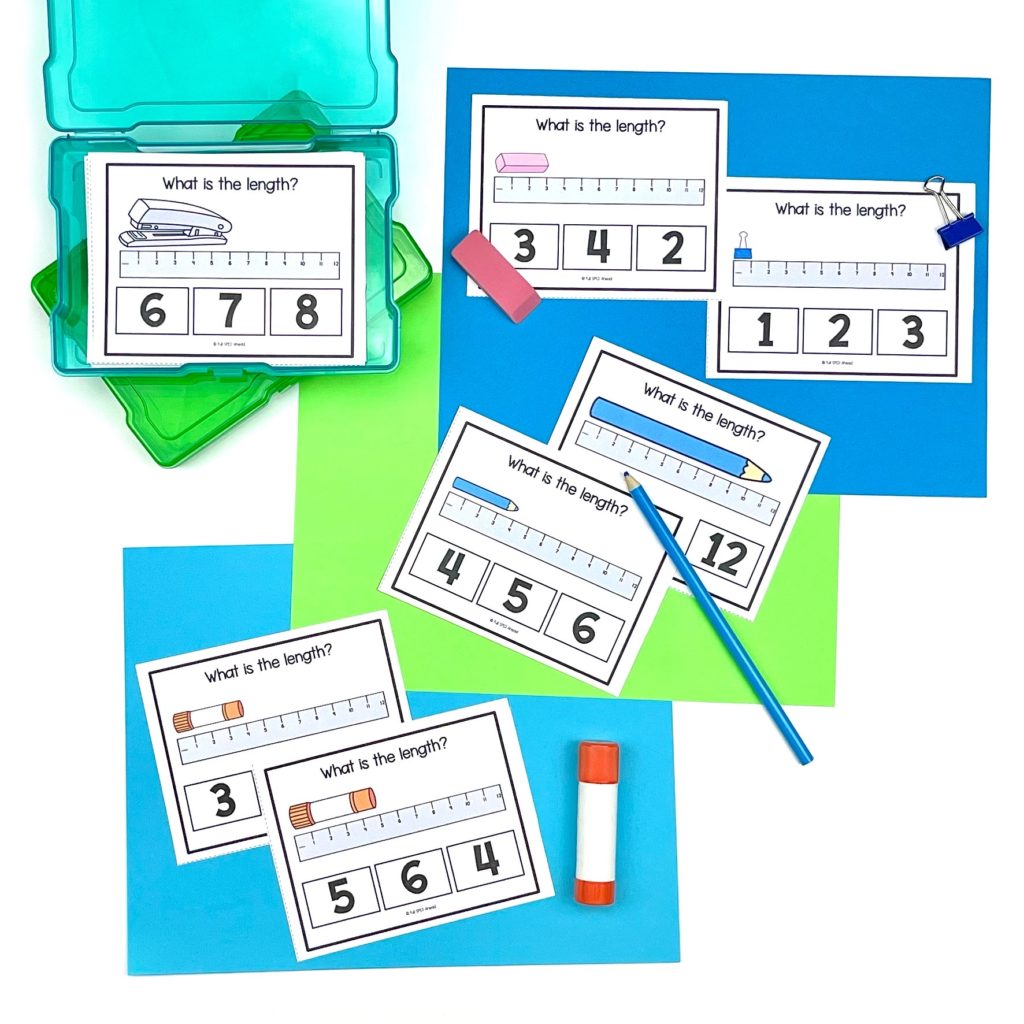
In the world of special education, teachers are beginning to use task cards for students. They are creating an effective and engaging learning environment. This is crucial for the growth and development of students with diverse needs. Task cards for students have emerged as a versatile and valuable tool for achieving this goal. In this blog post, we will explore how and why special education teachers can use task cards in centers for student work, highlighting the benefits and providing practical tips for implementation.
Read more about task cards for students here !
- Basic Skills Task Cards
- Kindergarten Task Cards
- 1st Grade Task Cards
- All Task Cards
The Power of Task Cards for Students in Special Education
Task cards are a versatile teaching resource consisting of individual cards, each with a specific learning task or question. They can cover a wide range of subjects and skills, making them adaptable to various grade levels and abilities. Here’s ways to use task cards into classroom centers for students:
1. Individualized Learning:
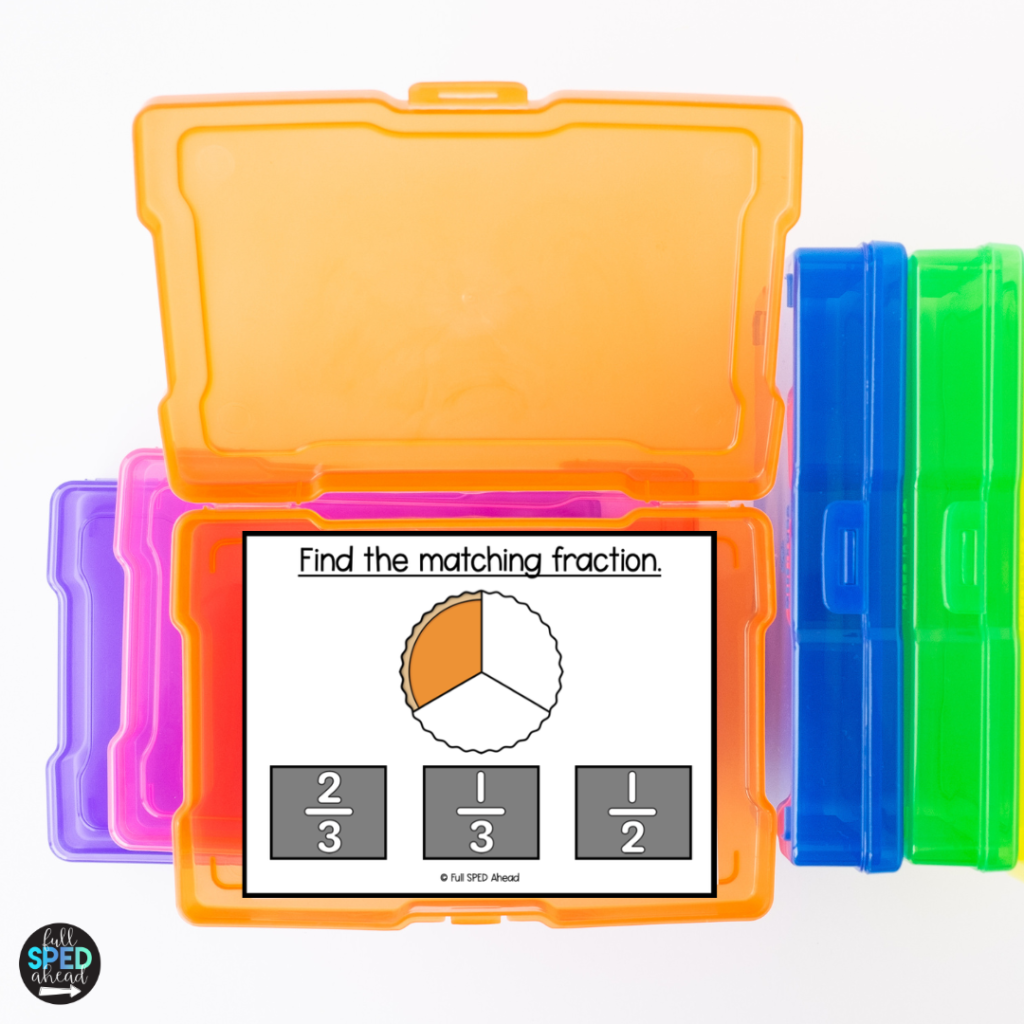
A ssess Student Needs: Before introducing task cards, it’s essential to assess each student’s strengths and weaknesses. Understanding their individual learning profiles will help you select or create task cards that align with their specific needs and goals.
Task Card Customization: Tailor task cards to match individualized education plans (IEPs) or learning objectives. Modify the content, format, or difficulty level to ensure that each student can engage with the material meaningfully.
Progress Tracking: Use task cards not only as instructional tools but also as progress monitoring tools. Keep records of how students perform on various task cards over time. This data can inform your teaching strategies and help you adjust instruction as needed.
2. Skill Reinforcement:
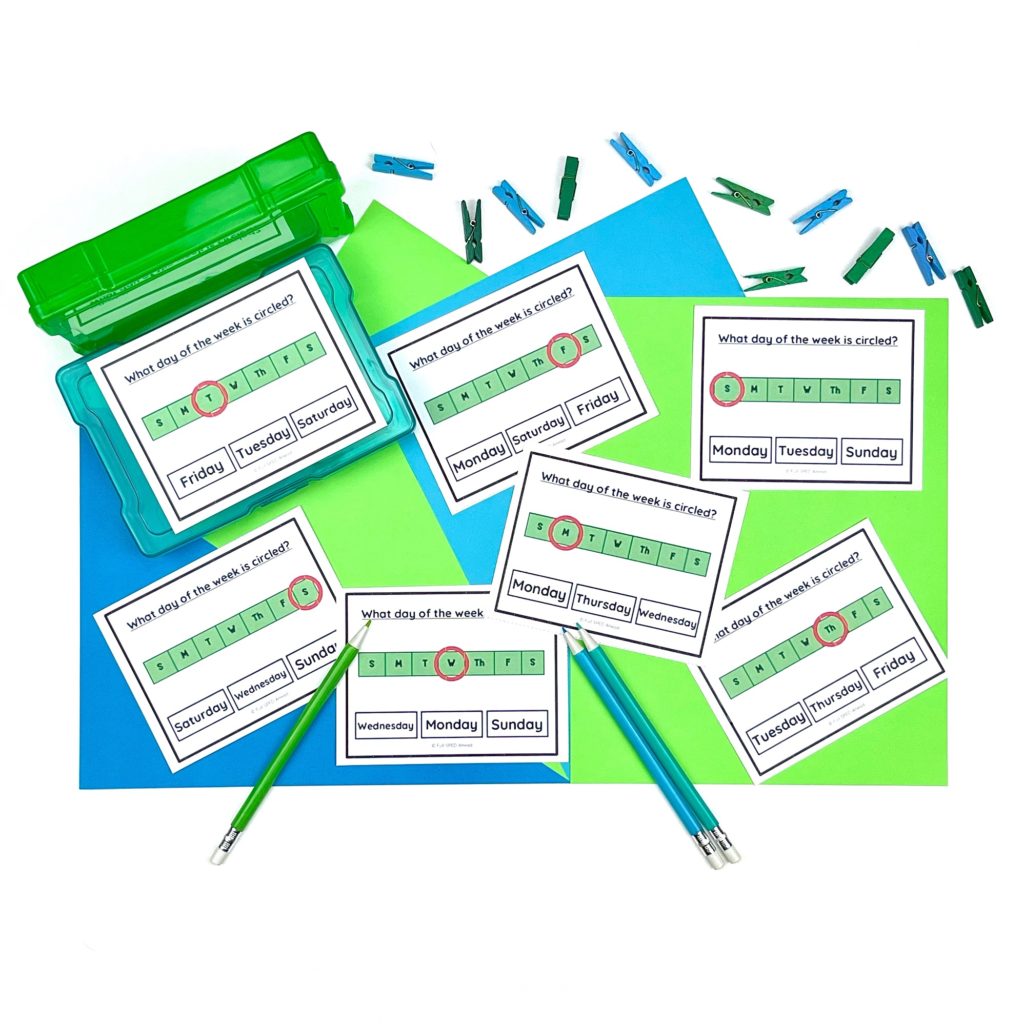
Scaffolded Learning: Task cards can be designed to scaffold learning progressively. Start with basic concepts and gradually increase the complexity of tasks as students demonstrate proficiency. This scaffolding approach ensures a smooth transition from foundational skills to more advanced ones.
Targeted Skill Focus: Identify specific skills or concepts that students need to reinforce. For example, if you’re working on math skills, task cards can address addition and subtraction at different difficulty levels. This targeted focus allows you to address individual skill gaps effectively.
Error Correction: While the goal of errorless learning is to minimize mistakes, it’s essential to teach students how to recognize and correct errors when they do occur. Include error correction strategies as part of the learning process to promote growth and resilience.
3. Engagement:
Multi-Sensory Integration: To boost engagement, consider incorporating multiple senses into task card activities. For instance, if you’re teaching vocabulary, use task cards with both written words and corresponding images or tactile elements. This multisensory approach caters to diverse learning styles.
Interactive Games: Transform task card activities into interactive games. Students can work in pairs or small groups, taking turns to complete tasks or answer questions. Gamification adds an element of competition and fun, increasing motivation.
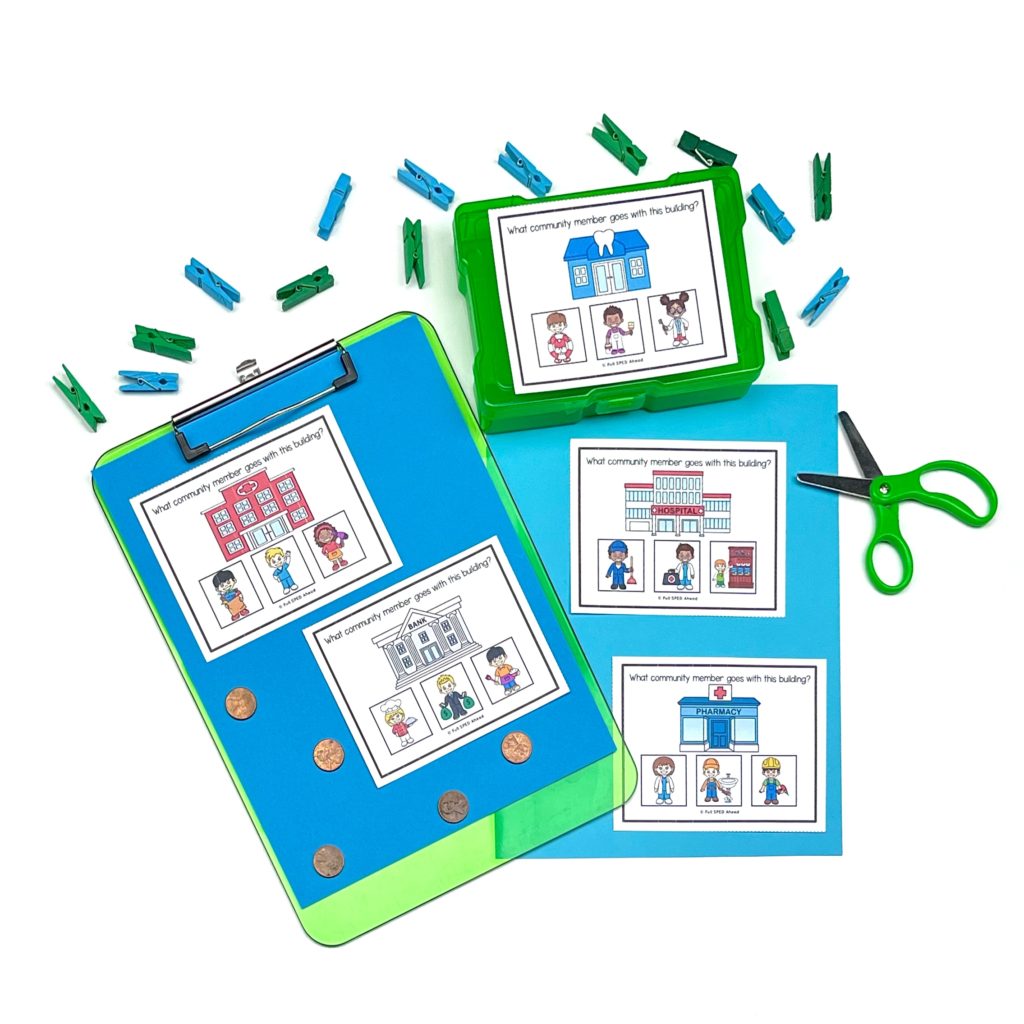
Choice and Autonomy: Offer students choices within the task card activities whenever possible. For example, let them choose the order in which they complete tasks or allow them to select from a menu of task card options. This autonomy fosters a sense of ownership over their learning.
4. Self-Paced Learning:
Flexible Timing: Recognize that students with special needs may require additional time to complete tasks. Task cards are ideal for self-pacing because students can work at their own speed. Allow extra time when needed, ensuring that students don’t feel rushed.
Visual Timers: Use visual timers or countdown clocks to help students manage their time effectively. These tools provide a visual representation of time passing, aiding students in self-regulating their work pace.
Checkpoints: Incorporate checkpoints within task card sets. These are predetermined breaks where students can review their progress and adjust their pace if necessary. Checkpoints promote self-awareness and time management skills.
5. Progress Monitoring:

Data Collection: Develop a systematic method for collecting data on student performance with task cards. This data should include accuracy, completion time, and any observed challenges. Regularly review and analyze this data to inform instructional decisions.
IEP Alignment: Ensure that the task cards align with the goals and objectives outlined in students’ IEPs. Track progress toward these IEP targets using task card activities and use the data for IEP meetings and reporting.
Intervention Planning: When you notice consistent difficulties or patterns of errors in task card performance, use this information to plan targeted interventions. These interventions can take the form of additional practice, modified task cards, or individualized instruction.
6. Independence:
Gradual Independence: Foster independence by gradually transitioning students from guided practice to independent use of task cards. Start with teacher support and reduce it over time as students gain confidence and competence.
Self-Monitoring: Teach students to self-monitor their progress and quality of work. Encourage them to check their answers or evaluate their completed tasks independently. Self-monitoring builds valuable self-regulation skills.

Peer Support: Consider implementing peer support systems where more independent students can assist others with task card activities. Peer tutoring promotes a sense of community and collaboration.
7. Differentiation:
Tiered Task Cards for Students: Create tiered sets of task cards that offer varying levels of complexity. This allows you to differentiate instruction within a single activity. Students can progress from basic to advanced task cards based on their readiness.
Choice Boards: Implement choice boards that provide students with options for task card activities. These boards can include tasks at different skill levels, enabling students to select activities that match their abilities and interests.
Flexible Grouping: Group students flexibly based on their needs and abilities for task card activities. Form small groups or pairs with mixed skill levels to promote peer support and collaboration with task cards for students.
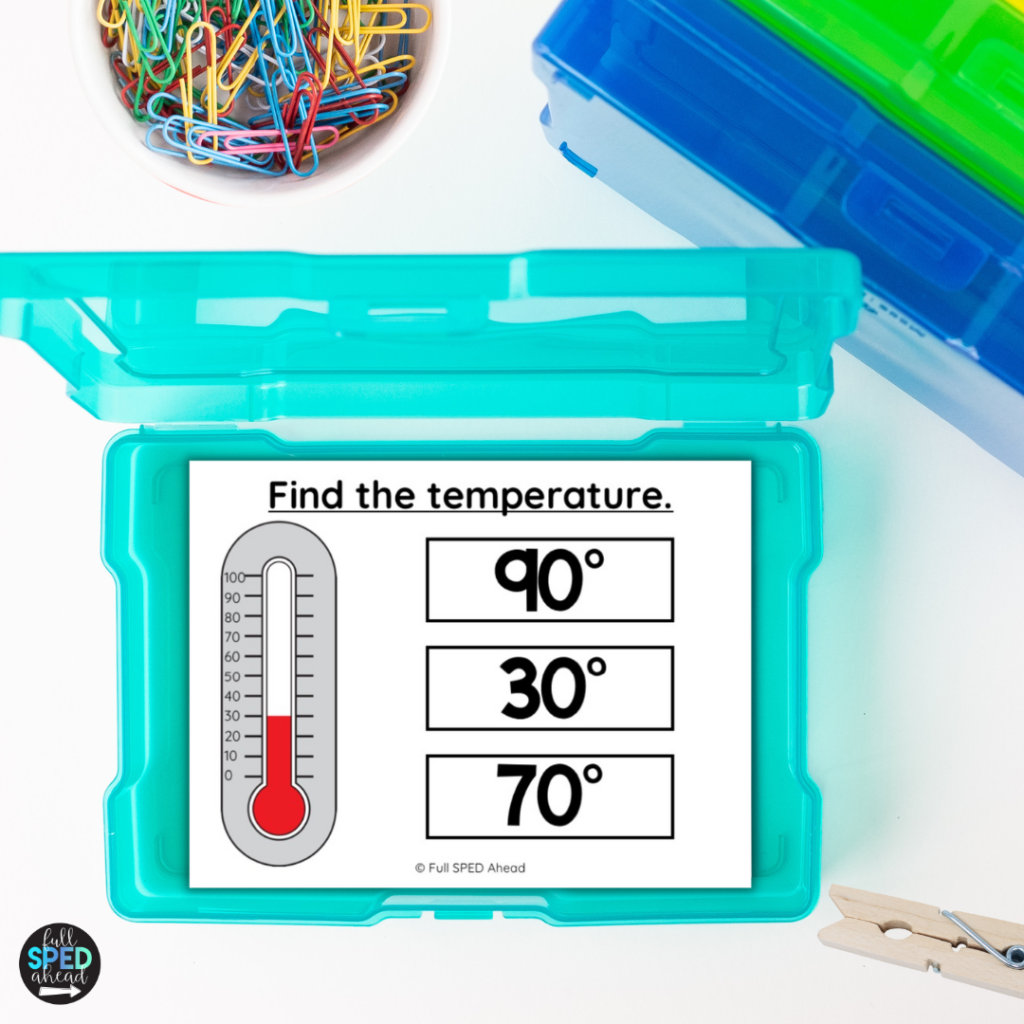
Practical Tips for Using Task Cards for Students
Now that we understand the benefits, let’s explore some practical tips for implementing task cards effectively in special education centers:
1. Start with Clear Instructions: Before introducing task cards to your students, provide clear and concise instructions on how to use them. Use visual cues or step-by-step guides if needed.
2. Organize by Skill Level: Group task cards by skill level or difficulty, so you can easily match them to each student’s needs. This organization simplifies the process of selecting appropriate tasks for each student.
3. Use Visual Supports: For students who benefit from visual supports, consider adding visual aids or cues to the task cards. This can include pictures, icons, or color-coded instructions.
4. Incorporate Hands-On Materials: Task cards can be paired with hands-on materials, such as manipulatives or sensory objects, to enhance learning. This multisensory approach can be particularly effective for students with special needs.

5. Offer Choice: Allow students to choose some of their task cards. This element of choice can increase motivation and engagement.
6. Rotate Task Cards: To keep centers fresh and exciting, periodically rotate the task cards to introduce new challenges and skills.
7. Include Social Skills: Task cards can be an excellent tool for teaching and reinforcing social skills. Create scenarios that require students to practice social interactions or problem-solving.
8. Collaborate and Share: Collaborate with other special education teachers to share task card resources and ideas. You can find a wealth of task card sets on educational websites and platforms like Teachers Pay Teachers.
Closing Thoughts
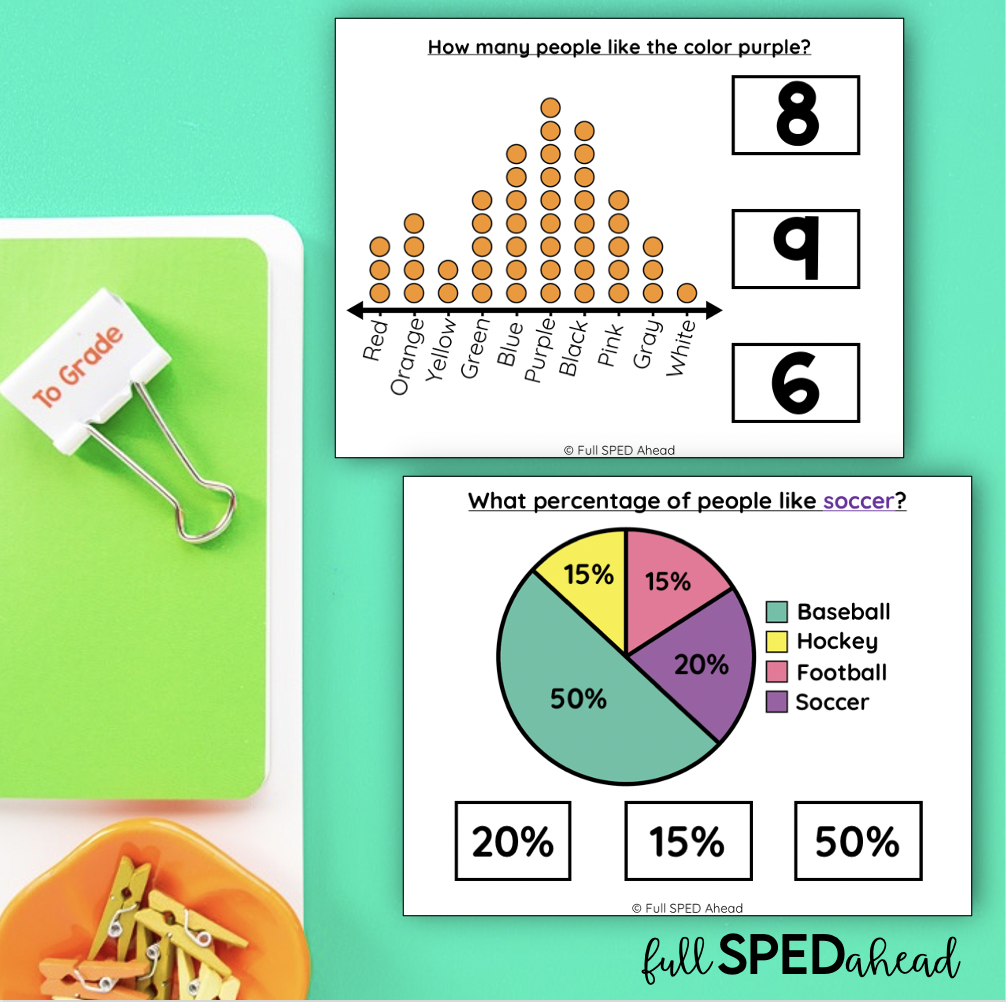
Task cards for students are a versatile and effective tool for special education teachers looking to create engaging and individualized learning experiences for their students. Their adaptability, engagement factor, and potential for skill reinforcement make them a valuable addition to any special education classroom. By following the practical tips outlined above, special education teachers can harness the power of task card activity to enhance student learning in your classroom and promote growth in a supportive and inclusive environment.
Instagram | TeachersPayTeachers | Facebook | Boom Learning Library | Pinterest | Youtube
What are you looking for?

Shop My Account Cart Wishlist Freebies
Behavior Curriculum Work Tasks Life Skills Morning Meeting
JOIN THE EMAIL LIST
COPYRIGHT © 2024 Full SPED Ahead
What is Special Education?
Special Education is a set of services provided to students who experience exceptional learning needs. Governed by federal law ( Individuals with Disabilities Education Act, IDEA ), special education is defined as: “Specially designed instruction, at no cost to parents, to meet the unique needs of a child with a disability.” Special education services may be provided across a variety of educational environments to students who have an individualized education program (IEP).
Eligibility for special education services requires that students have an identified disability that impacts their ability to learn and requires additional services and resources to effectively participate in school. Children who typically qualify for special education services include those with the following disabilities:
- Intellectual disability
- Hearing impairments (including deafness)
- Speech or language impairments
- Visual impairments (including blindness)
- Serious emotional disturbance
- Orthopedic impairments
- Autism spectrum disorder
- Traumatic brain injury
- Other health impairments
- Specific learning disabilities
- Developmental delay
Under the law, the IDEA ensures that regardless of a student’s disability or level of severity, schools must provide an appropriate education to ALL children with a disability (ages 3-21). It also requires that the following six principles be provided for students who receive special education services:
- Free and Appropriate Public Education (FAPE) — a public education at no cost to parents/guardians or children designed to meet the individual needs of each student, provide access to the general education curriculum, provides services in accordance to a student’s IEP, and results in an educational benefit to the child.
- Nondiscriminatory Identification and Evaluation — refers to the process and instruments used to identify individuals with a disability. Schools are required to use nonbiased methods as well as multiple approaches in the evaluation process to ensure that there is no discrimination on the basis of race, culture, or native language. All evaluation instruments must use the child’s first language. No identification or placement decisions may be based on a single evaluation instrument or test score.
- Individualized education program (IEP) — this document is the foundation of special education and specifically describes the services to be provided to the student with a disability. The IEP includes a description of a student’s current level of educational performance, information on how his or her disability influences academic performance, and details needed adaptations and accommodations. This document also specifies the educational settings in which the student will receive instruction in the least restrictive environment, the learning goals and objectives that will be addressed within a targeted year, behavior management plan (if needed), transportation needs, and related services.
- Least Restrictive Environment (LRE) — this indicates the educational settings in which a student with a disability receives special education services. The assumption is that all children will be educated alongside their peers without disabilities, to the greatest extent appropriate. It is only when it is determined that a student’s education cannot be achieved satisfactorily using supplemental aids and services in general classroom settings that alternative educational settings would be identified. At that time, the LRE might include special education services received part- or full-time in a resource room setting, a self-contained classroom setting, and/or community-based settings.
- Parent Participation — parents of a child with a disability must be a member of any group that makes decisions regarding the placement and LRE of their child. Parents have a right to notification of all meetings regarding their child’s placement, access to planning and evaluation materials, and notification of any planned evaluations. Both parents and students must be invited to attend IEP meetings.
- Due Process Safeguards — these include the protections afforded to children and their parents under IDEA. Safeguards include: obtaining parental consent for all evaluations and educational placement decisions, confidentiality of all records relating to a child with a disability, independent student evaluation at public expense, and due process hearings when the school and parent may disagree.
If you are ready to make a difference as an educator and learn new ways to nurture a modern classroom, earn your online Master of Science in Education in Special Education from Purdue University. Within this convenient online platform, you can reach your goals of higher education at an accelerated pace. Call 877-497-5851 to speak with an admissions advisor.
Many Students Can Get Special Ed. Until Age 22. What Districts Should Do

- Share article
School districts in most states have a responsibility under federal law to provide services to students with disabilities until they’re 21 or 22. But carrying out those responsibilities isn’t always intuitive.
Special education services often cost orders of magnitude more than what schools spend to educate students without disabilities. To make those investments, districts often have to dip into local funds when states and the federal government don’t contribute enough.
Staffing is also a pressing concern. Virtually every state has a shortage of educators who teach students with disabilities. And special education teachers in school buildings are often recruited to cover for classroom teachers or instructional aides when they’re absent or when positions are vacant.

Perhaps the most fundamental challenge, though, is what constitutes a “free, appropriate public education” given that disabilities rarely look the same from one student to the next.
Many parents don’t realize that their children with individualized education programs, or IEPs, are entitled to special education services subsidized by the school district even in their early years of legal adulthood, at a time when they might be on a waitlist for state services. District leaders, at their most helpful, can connect vulnerable students to services that improve their lives.
Here’s what experts say schools should be doing to meet these obligations and help students to the best of their ability.
Meet with students as early as age 14 to start transition plans
Schools shouldn’t wait until 11th grade to start helping students prepare for a future beyond high school. Those discussions must begin, according to federal law, by age 16. But starting earlier is better, said Audrey Trainor, a professor of special education at New York University who studies the transition from childhood to adulthood for people with disabilities.
The fundamental question as transition work begins, Trainor said, is: “Is the student going to graduate with their peers at age 18? Or do they need more time in school before transitioning to whatever’s next?”
Oftentimes these early meetings are parents’ first introduction to the idea that their student might remain in high school after their same-age peers have graduated.
Be prepared to negotiate with parents over what’s feasible and appropriate to offer
There isn’t a single correct path for a student with disabilities, even if a school has served other students with similar disabilities before.
As a result, schools should be ready to evaluate requests from parents for particular services, such as sending a student to a private provider or ensuring that a student has extensive one-on-one time with an educator throughout the day. Educators can weigh such factors as cost, evidence of effectiveness, and their own knowledge of a student’s ability to handle different types of services.
“A parent might ask for an accommodation, the school might come back and say, ‘We don’t see that that accommodation is necessary. Let’s try this other accommodation first,’” Trainor said.
Inform students of their rights
Once a child turns 18, they have a legal right to decide for themselves whether they want to remain in special education services.
“Sometimes IEP teams don’t necessarily inform students who are turning 18 that they have that right,” Trainor said. “And it also can be an uncomfortable conversation with parents whose children have disabilities.”
Students with disabilities may not feel empowered to decide for themselves on the best course of action. And some parents may disagree with their child’s assessment of what their next step should be.
Schools should be prepared to navigate these conflicts and conduct conversations sensitively, Trainor said.
Let parents know when opportunities outside the school system arise
The school’s job isn’t solely to provide adult students with services within the school building or through an out-of-district provider. Educators are also tasked with connecting students to services that get them out of the classroom, or out of the school district environment altogether, if that’s the most appropriate environment for the student.
One of the major opportunities comes through vocational rehabilitation services, typically provided by cities and states. Adults who take advantage of those services work with a counselor to develop an “Individualized Plan for Employment"—comparable to an IEP, but geared toward helping them identify job possibilities, career goals, and necessary workplace accommodations.
Vocational rehab helps with some of the basics of venturing into the professional world, like practicing for interviews and polishing resumes. But it can also include mental health counseling and physical therapy.
One key difference between school and vocational rehab, though, is that children and young adults with disabilities are legally entitled to school, whereas adults with disabilities don’t automatically qualify for vocational rehab. They have to apply and be deemed eligible for the service.
Many states have substantial waitlists for these and comparable services. In Illinois, school district administrators who work in special education often feel like the adult services the state provides aren’t sufficient, said Melissa Taylor, executive director of the Illinois Alliance of Administrators of Special Education.
“We do always advise parents that if an opportunity for an adult services-type placement opens up, even if it’s within that time when kids are still eligible for our programs, they should think seriously about taking it,” Taylor said.
Sign Up for EdWeek Update
Edweek top school jobs.

Sign Up & Sign In


- Resource Room
- Paraprofessionals
- IEP Masterclass
Starting a Task Box System in the Special Education Classroom
Special Education Teachers, chances are you've been searching for more age-appropriate activities that also support student independence. Maybe you've been hearing about work task boxes and independent work systems, but it all feels a bit overwhelming.
Whether you're a seasoned teacher or a new teacher just starting out in a self-contained classroom, I promise you, this is easier than you think and totally worth the effort. So, grab your favorite beverage, a set of headphones, and let's dive into setting up!
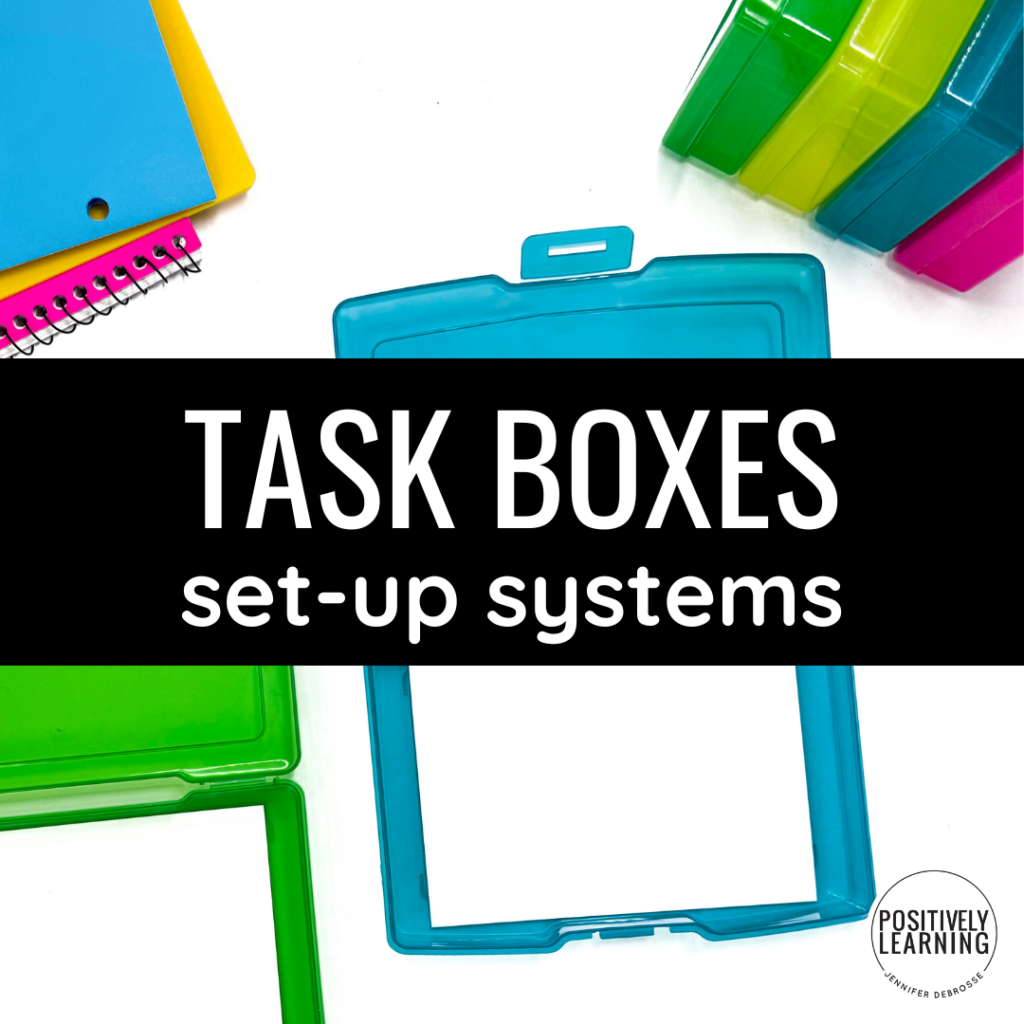
Table of Contents
What is a Task Box System?
A task box system is an independent work system designed to help special education students practice and master a variety of skills. It involves small, manageable tasks (think task cards or work bins) that students can complete independently. This system is a great way to facilitate independent skills, perfect for all grade levels and abilities.
Why Task Boxes?
There's so many reasons that task boxes are a major player in the special education classroom setting. Here's just a brief overview on why I think every teacher should strongly consider incorporating these magical skill boxes:
- Promotes Independence: They encourage independent work skills, which are important life skills for our students.
- Differentiation: You can easily customize the tasks to meet individual IEP goals, from fine motor skills to vocational skills.
- Engagement: Task boxes can be made interesting and fun (huge understatement!), ensuring students are engaged and learning.
- Easy to Implement: With resources like the dollar tree or simple plastic boxes, setting up a task box system is both affordable and straightforward.
Setting Up Your First Task Box System – Let's Do This!
- Start Small: Begin with a few task boxes. You can always add more as you and your students get comfortable with the routine.
- Choose the Right Tasks: Think about your students' skill levels and interests. Tasks can range from simple fine motor activities like using pipe cleaners, to more complex math activities or social studies concepts. Another great place to start is choosing tasks that align with student goals.
- Organize: Use plastic boxes, file folders, or even shoe boxes to keep your tasks organized. Label them clearly – you can even number them (task box number 1, task box number 2, etc.). I prefer using a color-coding system.
- Introduce to Students: Show your students how the system works. Use visual supports to make it easier for them to understand what to do.

Integrating Task Boxes into Your Classroom Routine
- Independent Work Stations: Set up a corner of your room for independent work stations where students can complete their task boxes.
- Small Groups: Use task boxes during small group time. It's a great way to differentiate instruction.
- Free Time: Allow students to choose a task box during free time. It’s a great way to turn unstructured time into a learning opportunity.
- Daily Schedule: Incorporate task boxes into your student schedules. This helps in creating a routine and expectations.
Tips for Task Box Success
- Variety is Key: Offer a variety of task boxes to cater to different interests and skill levels. Task Box Dollar Club is a time-saving, budget-friendly solution to build up your task box library quickly!
- Get Creative: Use resources like the dollar store or create your own tasks. You don’t need a high-quality printer, simple hand-made resources work great!
- Involve Your Team (IF you have one): Involve a staff member in managing the task box library. Many years I was alone and it was completely manageable (that is – the task boxes were, not all the rest we do!).
- Track Progress: Use a data sheet to keep track of which task boxes each student has completed and how they performed (a variety of data tracking pages are included in the Task Box Dollar Club).

You've Got This!
Starting a task box system in your special education classroom is a great way to cultivate independent skills, meet IEP goals, and engage students in meaningful activities.
Remember, it does NOT have to be complicated or expensive! With some creativity and a few basic supplies, you can create a system that works wonders for your students. Find everything you need in ONE place inside the club – check it out here:

I'm Jennifer!
I’m Jennifer and I was a special educator in the elementary school setting over the past decade. I entered the classroom every day dedicated to making learning inclusive AND engaging.
On the Blog

In the Shop
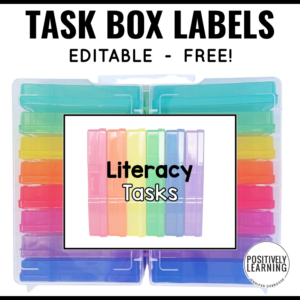
Task Boxes Free Labels for Classroom Organization

IEP Progress Report Card Comments

Classroom Routine Rubrics

- Privacy Policy
- Special Education
- Reading Intervention
- Organization
- More Topics
- Data Collection
- Teacher Gifts
- Shop on TPT
- Free-Sources

Differentiation delivered to your inbox
This website uses cookies to ensure you get the best experience on our website. See full disclosure here.
- svg]:stroke-accent-900">
Air Force special ops commander fired after domestic violence arrest
By Jeff Schogol
Updated on Jun 26, 2024 4:59 PM EDT
3 minute read

An Air Force special operations commander who oversaw training AC-130 gunship crews was relieved of command this week after being arrested for allegedly choking a woman and child.
Air Force Lt. Col. Brent P. Byng was relieved as commander of the 19th Special Operations Squadron on Monday, according to Air Force Special Operations Command, or AFSOC, after being arrested on June 23 on domestic violence and related charges.
“Command is a privilege, not a right,” AFSOC said in a statement. “The Air Force has a strict zero-tolerance policy for illegal activity conducted by its members on or off base and holds commanders to the highest standards. In the interest of the unit, the member, and the Air Force, Lt Col Byng was relieved from command for cause.”
Byng was arrested by the Santa Rosa County Sheriff’s Office in Florida on June 23 for allegedly choking a woman and a child, according to an arrest report from the sheriff’s office that was provided to Task & Purpose.
Subscribe to Task & Purpose today. Get the latest military news and culture in your inbox daily.
He accused his wife of cheating on him and demanded that she give him her phone, the report says. She walked into the bedroom, but he followed her and grabbed her neck until she couldn’t breathe.
When Byng let go of his wife, she gave the phone to one of her two children and told them both to run, the report says.
Byng allegedly used a pocket knife to threaten his children, telling them to give him the phone. The children ran out of their home “in fear for their lives” and Byng allegedly followed them with the knife.
He started choking one of the children on his front porch but he released the child when a friend pulled into the driveway. His wife then brought both children inside and told them to hide in the master bedroom while she scaled a backyard fence to call for help from a neighbor’s home.
Byng’s wife and children all told the sheriff’s office they felt he was trying to take the phone so that they could not call police, the report says.
Byng has been charged with felony counts of cruelty towards a child, obstructing justice, battery, and aggravated assault, according to the Santa Rosa County Sheriff’s Office.
A member of Byng’s family reached by phone on Wednesday told Task & Purpose that he did not want to comment for this story.
Byng had led the squadron at Hurlburt Field, Florida for little more than a month, according to AFSOC. His official biography was not immediately available and an interim commander has been appointed, officials said. The 19th SOS trains flight crews of the AC-130 and MC-130, the specialized gunship and tankers versions of the C-130 cargo plane flown by AFSOC.
AFSOC said it is aware of Lt. Col. Byng’s arrest and Air Force officials are fully cooperating with the local authorities, adding that the incident is being investigated by local law enforcement.
“We have full confidence in our community partners to conduct a thorough and fair investigation into this incident and are cooperating fully with any requests they have,” AFSOC said.
UPDATE: 06/26/2024; this story was updated with information from an arrest report from the Santa Rosa County Sheriff’s Office.
The latest on Task & Purpose
- Uniform inspections and stricter shaving rules coming in renewed Air Force focus on ‘standards’
- One of the Army’s top Nuclear teams trained with Rangers and Green Berets
- The 4th Infantry Division’s huge obstacle course looked like the zombie apocalypse
- Army barber’s 57 year legacy with the Airborne leads to haircutting hall of fame
- Master Chief William Goines, first Black Navy SEAL , passes away at 88
Latest in Air Force
Airman killed, 2 first responders hurt in vehicle crash at malmstrom air force base airman killed, 2 first responders hurt in vehicle crash at malmstrom air force base, two-star air force general found not guilty of sexual assault, guilty on other charges two-star air force general found not guilty of sexual assault, guilty on other charges.
By Nicholas Slayton
Sign Up For Our Newsletters
The latest military news and entertainment delivered right to your inbox.
By signing up you agree to our Terms of Service and Privacy Policy .

Texas doesn't fund special education enough — and it's hurting districts' pockets

Shawnda Kracja doesn’t want her daughter to be known as “the deaf kid.”
Kracja’s daughter is an incoming third grader at Davis Elementary, which has hosted a regional day school program for the deaf and hard of hearing for decades. But the other deaf and hard of hearing students at Davis will be moving to Harrington Elementary for the 2025-2026 school year. The Plano ISD board of trustees recently voted to close Davis and three other schools, citing budget concerns.
Plano is one of many school districts in Texas faced with hard decisions because of funding shortfalls. Disability advocates say special education funding in Texas falls short by about $2 billion — leaving school districts to foot the bill. And even wealthy districts are struggling to come up with the missing funds.
More Texas students are enrolling in special education. Texas had a cap of about 8.5% for special education enrollment until 2018. Now that the cap has been removed, Steven Aleman, a senior policy specialist with Disability Rights Texas, said more students are enrolling in special education services.
Special education students cost more to teach, which Aleman said should mean the state would provide districts extra funds to supplement the added expense. Districts do typically get extra money for special education from state and federal dollars. But Aleman said the amount of money districts get from the state for special education isn’t enough to meet the growing need.
“There's a shortfall or a gap between what districts are spending, that is what it cost collectively to educate students with disabilities, and what the state is taking responsibility for,” he said.
Aleman said the shortfall amounts to about $2 billion. On top of that, schools in Texas lost $300 million in federal special education funds late last year. The Texas Health and Human Services Commission lost an appeal to a federal audit that found it was overbilling Medicaid for special education services.
Aleman said the loss of that federal check on top of the funding gap from the state hurts districts’ pocketbooks.
“Those federal and state reimbursements are just not keeping up,” he said.
Community Integration
Liz Whitaker isn’t deaf. But the incoming fourth-grader has learned some sign language.
“So I could communicate more with my friends,” Whitaker said.
Kracja said the inclusive culture at Davis makes a difference for her daughter.
“My daughter is just one of the girls,” she said. “They don't see her as, ‘oh, that's the deaf kid.’”
Kracja said it took years to build that campus culture — and moving the program to Harrington means starting over.
It’s not just about the students. Kracja said the teachers at Davis are accustomed to the needs of deaf and hard of hearing students. Some of them have ASL interpreters. Others have a hearing aid or a cochlear implant that connects to a microphone their teacher wears.
Sarah Wainscott, an assistant professor of deaf education at Texas Women’s University, said it will be an adjustment for teachers at Harrington who haven’t worked with deaf and hard of hearing children. And Wainscott said having a teacher who understands the varying needs of deaf and hard of hearing students makes a difference.
“Having a teacher that knows those things intuitively based on experience is a game changer,” she said.

Higher Costs
There’s extra money allocated in the state budget for regional day programs like the one at Davis Elementary. Districts who contribute dollars can send students to the nearby location that meets their needs if they don’t have a program. The special education funding those students receive follows them to the district they attend for the day school program.
Aleman said in theory, that money should be enough to fund the day school program and provide for the deaf and hard of hearing students’ educational needs.
“That’s not the reality,” he said. “They are shortchanged, just like all other students with disabilities in the state.”
There aren’t many students who are deaf or hard of hearing. About two to three out of 1,000 children in the country are born with detectable hearing loss according to the National Institute on Deafness and Other Communication Disorders. That’s why the program at Davis Elementary serves so many districts.
But Wainscott said teaching students who are deaf or hard of hearing is pricier.
“Our tech has gotten better and better and better, but it's also got more and more expensive,” she said.
Plano ISD said closing the schools was a difficult but necessary financial decision. The district has had a growing budget deficit since 2017. Plano’s chief financial officer, Johnny Hill, said at the meeting that closing these campuses will save the district about $5.2 million annually. Other savings include a one-time $20.1 million capital expenditure reduction and avoiding the cost of rebuilding the four campuses, which would’ve cost at least $340 million. The four schools were all built during the 1970s.
Plano ISD is in an area with a lot of property wealth — but it doesn’t get to keep all of the property tax dollars it collects. The state sets a certain amount of money school districts get per student. It’s called the basic allotment. It’s about $6,160 per student. Special education students typically receive extra dollars through an additional allotment.
Any extra money Plano ISD collects gets sent to the Texas Education Agency to be redistributed to districts with less property wealth.
The basic allotment hasn’t gone up since 2019. But Plano ISD Superintendent Dr. Theresa Williams said at a recent school board meeting that inflation has increased the district’s expenses.
“From compensating our employees to the rising cost of construction to the cost of materials, resources, insurance, shield, utilities, the cost of doing business today can't adequately be done with 2019 budget dollars,” Williams said.
There was a bill in the Texas House during the last legislative session that would’ve raised the basic allotment. Aleman said the bill also included changes to the state’s special education funding formula, something he said Disability Rights Texas championed. He said the current formula is overly complex and outdated.
The bill didn’t move forward after the House passed amendment to remove school voucher funding from the bill. Gov. Greg Abbott said he would veto any education funding legislation that didn’t include money for what he refers to as ‘school choice.’
Aleman said Abbott’s political differences over vouchers killed the bill.
“If he didn't get that, then nothing was going to pass about school funding,” Aleman said.

Far-Reaching Problem
Plano ISD isn’t alone in its struggles. School districts in Irving and Richardson also recently closed schools because of declining enrollment. Less kids in the classroom means less money from the state and more empty desks. Hill said that too many open seats at schools is inefficient — the schools can’t offer certain programs because there aren’t enough participants, and the district ends up paying for more facilities than it needs.
Plano ISD’s enrollment has gone down by 7,700 students the past 12 years. And Hill said it’s projected to keep declining by over 3,000 students the next five years. There are about 18,000 open seats in Plano schools right now. Hill said if the district doesn’t do anything, that’ll go up to 21,500 open seats.
“That’s just not sustainable over time,” he said.
Closing the campuses was an emotional moment. Parents wearing Davis Elementary shirts walked out of the school board meeting in tears after the trustees voted unanimously to close the four campuses.
Even the school board president, Nancy Humphrey, shed a tear.
“I’m sorry,” Humphrey said as got choked up ahead of the board’s vote. “I’m human.”
They’re thinking of kids like Liz Whitaker.
“I don’t think that we should shut down Davis because we have an amazing community of a lot of amazing people,” Whitaker said.
But as expenses increase and funding stays stagnant, school districts will have to continue to face tough choices — even wealthy districts like Plano ISD.
Dylan M. Rafaty, the president and CEO of the North Texas Disability Chamber, said he understands parents’ concerns about closing Davis Elementary. But Rafaty, who’s deaf in his right ear and partially deaf in his left ear, said the rest of the world isn’t as inclusive as Davis.
“I'm encouraging those parents to understand that as you integrate into society, it becomes more challenging,” Rafaty said.
The Plano West graduate said he’s confident the district will do everything possible to ease the transition for families at Davis. And he said the best way to rebuild the culture at Davis is for deaf and hard of hearing students to learn to advocate for themselves.
“We want to be a part of our community,” Rafaty said. “We want to be engaged. We just need the support from those around us to understand and welcome us and accept us.”
Got a tip? Email Caroline Love at [email protected] .
Caroline Love is a Report For America corps member for KERA News.
KERA News is made possible through the generosity of our members. If you find this reporting valuable, consider making a tax-deductible gift today. Thank you.

Elektrostal (Q198419)
| Language | Label | Description | Also known as |
|---|---|---|---|
| English |

Wiktionary (0 entries)
Multilingual sites (0 entries).
- Pages with maps
Navigation menu

IMAGES
VIDEO
COMMENTS
Independent work task boxes can be used for basic skills practice and IEP goals (math facts, spelling words, etc.). Following direction tasks or listening comprehension task cards. Vocational education skills and work tasks like matching, categorizing, and sorting. Combine a fine motor task with new skills and meet multiple students' needs.
Task boxes provide an engaging and effective way to help special education students develop valuable life skills. If you're looking for inspiration to create your own task boxes or simply want more ideas, be sure to download "The Ultimate Task Box Idea List: 101 Fun and Educational Activities." This comprehensive resource is packed with age-appropriate activities for students of all skill ...
Task boxes (also known as work boxes) are structured work systems created by Division TEACCH t the University of North Carolina Chapel Hill. This system allows the student to work independently on a task for a specific time in a supportive environment. Task boxes are now used for students with a variety of disabilities including students ...
What are task boxes for special education. First things first, let's break it down. Each box contains hands-on activities designed to help our special education students practice and master specific skills. Whether it's math, literacy, fine motor skills, or life skills, task boxes are our secret weapon for making learning fun, engaging, and ...
In a nutshell, task boxes are self-contained, independent work tasks that cater to a wide range of skills and grade levels. From enhancing fine motor skills to teaching literacy, math, and social skills, these tasks a high on engagement. Task Cards Vs. Task Boxes. While task boxes contain the materials needed for a particular task, task cards ...
Put-in tasks are simple task boxes that are a basic starting point for students in special education who have limited or no ability to work independently. They are the perfect place to start for students just beginning in independent work systems. This particular task is the most basic because it is self-contained, so the student does not need to organize any materials.
Task boxes play a vital role in our special education classrooms, offering a range of benefits for students with diverse needs. From promoting independence and autonomy to targeting specific skills, these structured learning opportunities enhance engagement, facilitate progress monitoring, and support differentiated instruction.
In special education classrooms, task boxes can be utilized for various objectives. Common applications include: Teaching academic skills: Task boxes can be used to introduce a variety of intellectual abilities, including mathematics, reading, writing, and science. They may include worksheets, manipulatives, and other hands-on things required ...
Teach, Task Box, Inspire: The Podcast is your go-to educational podcast dedicated to making your job as a special education teacher easier and more enjoyable. Your host, Lisa Hollady, is a veteran special education teacher with a passion for helping teachers like you make a real difference in the lives of your students.
Independent work tasks are important in every special education classroom! These task boxes can be used as teaching tools and building independence through student work. This resource includes detailed instructions for teacher setup, Amazon list of possible materials, digital data tracking form, student visuals, teacher visuals and directions ...
1. One-on-One Instruction. These boxes can easily be used by teachers or paraprofessionals in a 1:1 instructional setting. You can use them to teach new skills or even skills that they have been working on for a while. Using them for direct instruction is the main way we are utilizing task boxes in my classroom. 2.
These math task boxes can be used all year and have a variety of skills (32 skills to be exact), depending on your students' IEP goals. Some skills that these contain are counting to 20, more or less, addition, subtraction, tracing numbers, telling time, counting coins and patterns, just to name a FEW! Try a FREE sample math task box here!
The trains in my Detail Discrimination tasks are a good example for a task box system. 5. Visual and Engaging. Finally, it helps to have task boxes for special education students that are visual and interesting. Students are more likely to engage with task box activities that they find interesting, so incorporate special interests.
Fall-Themed Task Box. As a special education teacher and blogger, I recently curated a fall-themed task box bundle that I am excited to share with you. Introducing the "Fall Task Box," a collection of engaging and age-appropriate activities designed to improve fine motor skills and are a great way to explore the beauty of autumn.
As a special education teacher or a parent of an autistic student, finding effective teaching tools and independent work activities can be a challenge. ... The Vocational Work Task Mega Pack includes 25 engaging work tasks, specifically designed for special education teachers and parents of autistic students. These tasks are not only effective ...
Independent work tasks are important in every special education classroom! These task boxes can be used as teaching tools and building independence through student work. This resource includes detailed instructions for teacher setup, Amazon list of possible materials, digital data tracking form, student visuals, teacher visuals and directions ...
The keys steps needed to complete this task are: Look up at the flashed alphabet. Process and retain the information in the learner's working memory. Look down at the piano keys. Find the corresponding key by scanning past non-target keys. Identify and stop at the target key. Aim and press with one finger. 4.
2. Skill Reinforcement: Scaffolded Learning: Task cards can be designed to scaffold learning progressively. Start with basic concepts and gradually increase the complexity of tasks as students demonstrate proficiency. This scaffolding approach ensures a smooth transition from foundational skills to more advanced ones.
Special Education is a set of services provided to students who experience exceptional learning needs. Governed by federal law (Individuals with Disabilities Education Act, IDEA), special education is defined as: "Specially designed instruction, at no cost to parents, to meet the unique needs of a child with a disability." Special education services may be provided across a variety of ...
School districts in most states have a responsibility under federal law to provide services to students with disabilities until they're 21 or 22. But carrying out those responsibilities isn't ...
A task box system is an independent work system designed to help special education students practice and master a variety of skills. It involves small, manageable tasks (think task cards or work bins) that students can complete independently. This system is a great way to facilitate independent skills, perfect for all grade levels and abilities.
I noticed that the Planner App in Microsoft Teams is no longer showing Private/To Do tasks or Flagged emails. This is true in both the Teams Desktop client as well as Teams for the Web. However, they do appear in the Planner app within the Mobile Teams app. I am on targeted release and have attached my version information.
A record 7.5 million students accessed special-education services in U.S. schools as of 2022-2023, including children with autism, speech impairments and attention-deficit hyperactivity disorder ...
Air Force Lt. Col. Brent P. Byng was arrested in Florida. He had led the 19th Special Operations Squadron for little more than a month. Air Force Lt. Col. Brent P. Byng has been relieved as ...
We are excited to announce the rollout of Planner premium plan task syncing with Planner and To Do. With this, users will be able to view their premium plan tasks seamlessly integrated within the "Assigned to me" view in To Do, Planner web as well as the new Planner app.. The feature is being rolled out in phases and would be available across geographies in coming weeks.
More Texas students are enrolling in special education. Texas had a cap of about 8.5% for special education enrollment until 2018. Now that the cap has been removed, Steven Aleman, a senior policy ...
capital of. Elektrostal Urban Okrug. 1 reference. located in the administrative territorial entity. Moscow Oblast. start time. 14 January 1929 Gregorian. 1 reference. Elektrostal Urban Okrug.
Elektrostal. Elektrostal ( Russian: Электроста́ль) is a city in Moscow Oblast, Russia. It is 58 kilometers (36 mi) east of Moscow. As of 2010, 155,196 people lived there.
In 1938, it was granted town status. [citation needed]Administrative and municipal status. Within the framework of administrative divisions, it is incorporated as Elektrostal City Under Oblast Jurisdiction—an administrative unit with the status equal to that of the districts. As a municipal division, Elektrostal City Under Oblast Jurisdiction is incorporated as Elektrostal Urban Okrug.
Due to various technical and methodological challenges, PISA has to date offered only limited accommodations for students with special education needs (SEN). As a result, some students are currently excluded from the PISA target population at the sampling stage, and in some countries, exclusion rates are growing as more and more students are ...